NEW HARMONY
5 Year Parks Plan
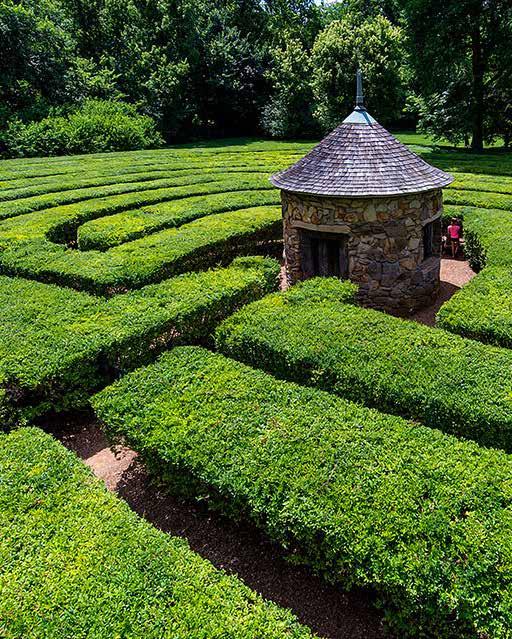

5 Year Parks Plan

It is with gratitude that we acknowledge the many individuals from the Town of New Harmony who helped develop this plan.
Town Of New Harmony Town Council
Lora Arneberg, Economic Development
Rod Clark, Public Works
Jeff Smotherman, Public Safety & Administration
Connie Weinzapfel, Streets & Streetscapes
Tom Williams, Parks & Recreation
Town of New Harmony Parks & Recreation Board
Andy Batt, Secretary
Zachary Clark
Jeanne Maudlin, President
Jim Ries
Town of New Harmony Planning Steering Committee
James Alsop
Connie Armstrong
Mike Axton
Charles Bandy
Christine Crews
Michael Guard
Erik Janik
Docey Lewis
Jeanne Maudlin
Cesar Oliverez
Allison Pinnick
Diane Sanders
Teresa Smith
Johnathon Webber
Connie Weinzapfel
Dawn Worman
Town of New Harmony 5-Year Parks Plan Steering Committee
Andy Batt
Zachary Clark
Laura Dunigan
Tom Guggenheim
Marlene Huffaker
Jeanne Maudlin
Kelley Morgan
Jim Ries
Tom Williams
Plan Developed By Rundell Ernstberger Associates
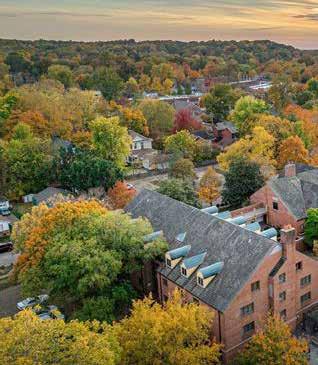

The 5-Year Parks Plan for New Harmony, Indiana, is a guide for the development, maintenance, and improvement of the town’s parks and trails. The town is excited to develop this plan, which is the first 5-Year Parks Plan for New Harmony since 1984. As the town continues to evolve, this plan provides a strategic framework for ensuring its parks meet the needs of residents and visitors. Parks play a vital role in enhancing the quality of life, such as promoting health and wellness, and preserving the town’s natural beauty.
The 5-Year Parks Plan is a living document that guides decision-making and project implementation for the town’s parks system over the next five years. It will serve multiple purposes:
• Planning and prioritization: The plan outlines key projects, goals, and initiatives for improving park facilities in New Harmony. It helps the community prioritize which projects to consider first, based on resources, needs, and impact.
• Public accountability: The plan provides transparency and accountability by outlining objectives and recommendations, allowing the community to track progress over time.
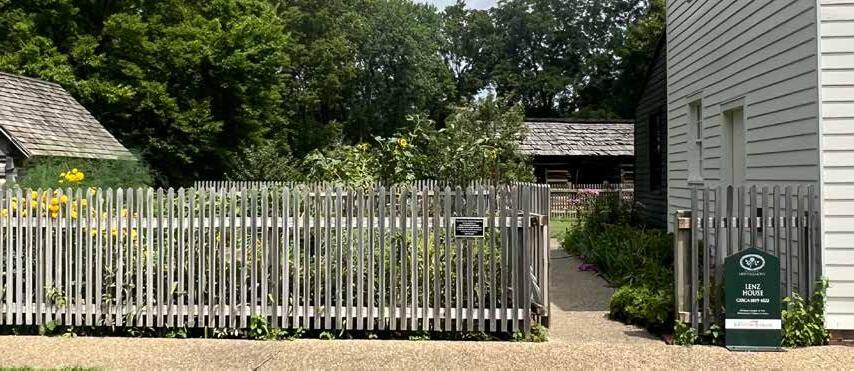
This plan is intended to be used by a variety of stakeholders, including town representatives and residents. For elected officials, the plan serves as a roadmap for setting priorities, scheduling improvements, and securing funding. For the community, the plan is a reference to understand the future of New Harmony’s parks and provide feedback or participate in upcoming projects. Each section of the plan provides information into current conditions, recommendations for future improvements, and strategies for achieving long-term goals. By consulting the plan, all can stay informed and engaged with the ongoing development of the town’s parks.
The development of the 5-Year Parks Plan involved a collaborative process over multiple phases to ensure that the final plan reflects the needs and goals of the entire town. The planning process included four key steps:
1. Discovery: The first step in creating the plan was to conduct an assessment of the current parks, Murphy and Maclure Park. This phase involved collecting data on the condition of parks, including existing amenities. A detailed inventory was taken to understand what is working well and where improvements may be needed.
2. Public Engagement: Input from the community was important to define the vision and goals of the plan. During the public engagement phase, a series of workshops, surveys, and focus group discussions were held to gather feedback from residents, and local organizations. These conversations helped identify the community’s needs, preferences, and priorities for both the town and it’s parks.
3. Analysis: In the analysis phase, the data collected during discovery and public engagement was carefully reviewed. The needs of the community were compared with existing park facilities to identify gaps and opportunities. This analysis also considered trends in demographic information, and other factors that might influence parks planning.
4. Envisioning & Implementation: After gathering and analyzing the data, the planning team worked to create a shared vision for the town’s parks. This phase focused on setting both shortterm and long-term recommendations for park improvements. This phase includes identifying a timeline for executing park projects over the next five years.
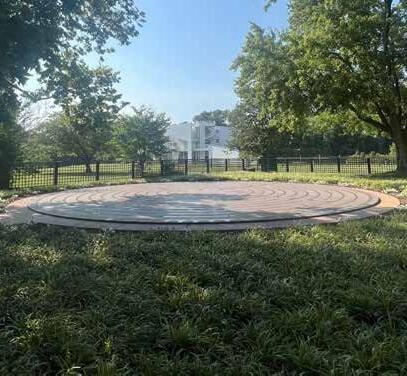
The Town of New Harmony is located in the northwestern area of Posey County on the southwestern tip of Indiana. Bordering Posey County is Vanderburgh County to the east and Gibson County to the north. The meandering Wabash River serves as the western border separating the county (and state) from Illinois. The county was formed in 1814 from sections of both Gibson and Warrick Counties and named after Thomas Posey.
(2008 Comprehensive Plan)
The town is located near state highways and interstates, also making it accessible for visitors traveling from surrounding areas. New Harmony’s mixture of historical significance and access to natural features contribute to its appeal as both a residential community and a tourist destination.
New Harmony Park Board’s jurisdiction includes all of the incorporated areas of the Town of New Harmony, which is organized in a compact grid pattern that is beneficial for pedestrian and golf cart use. At the center of New Harmony is the historic district, which includes important landmarks, cultural institutions, and local businesses, all of which contribute to the town’s unique character. The town currently manages Maclure Park, Murphy Park, and the trails around the old school property and along the east side of the Wabash River.
However, the research area extends beyond the jurisdictional boundaries of the Town. Visitors arrive from throughout the Midwest and the United States given the unique history of the town, and contemporary landmarks.
Town festivals also attract regional visitors from
cities as far as Indianapolis, St. Louis, and Lexington. Furthermore, the natural features such as Harmonie State Park and the Wabash River dictate a review and study beyond the town boundary.
New Harmony has a Parks & Recreation/Tree Board that is made up of four members. In addition, one representative from Town Council oversees “Parks, Trails, Riverbanks, and Cemetery.” New Harmony does not have paid staff positions.
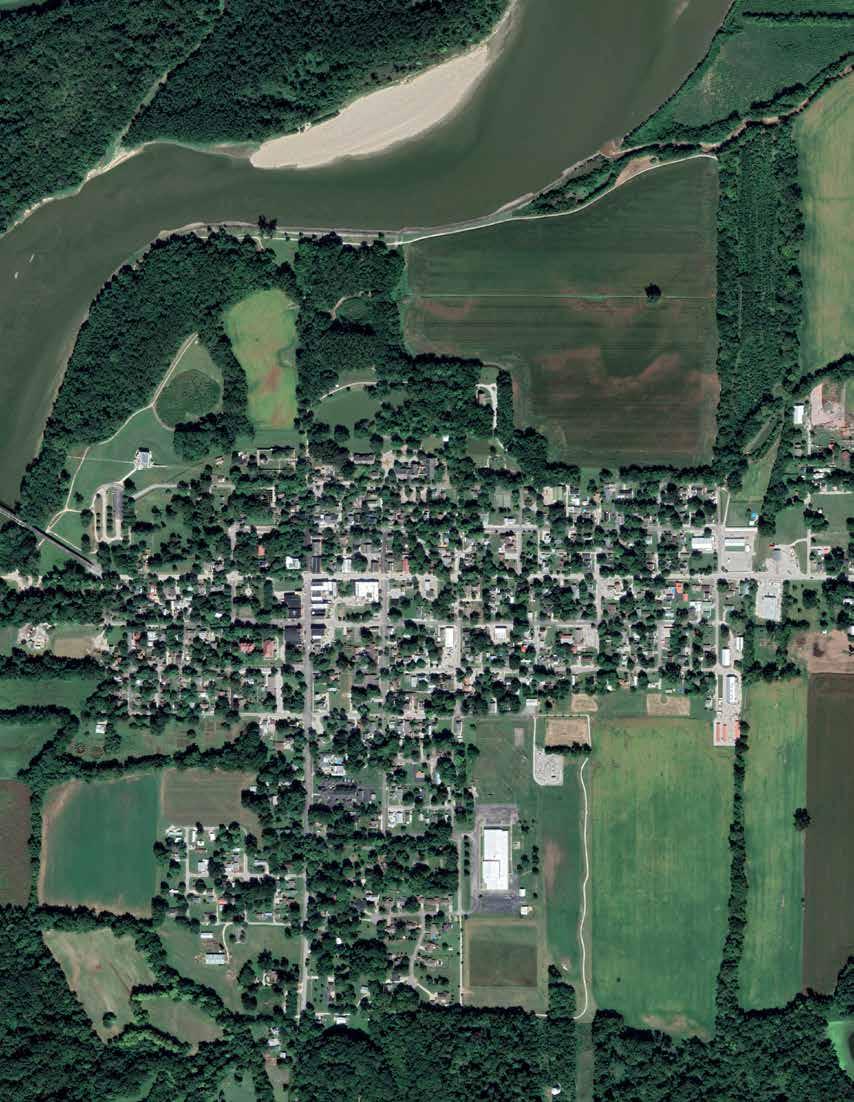
Goals and Objectives of the 5-Year Parks Plan for New Harmony, Indiana
The 5-Year Parks Plan is designed to maintain, enhance, and increase amenities in New Harmony’s parks. The chief goal of the Parks Board is to update the master plan for parks and recreation within the Town, including a operating budget. To achieve this, the plan establishes direction for park improvements, focusing on four main goals.
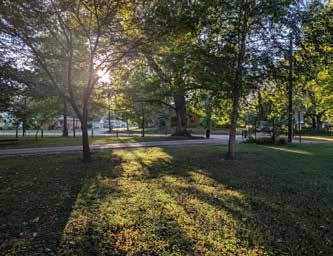
The cultural and historic landmarks that are found in New Harmony should be protected through the enhancement of the natural beauty of the town’s parks and trails. The parks can be seen as extensions of the town’s unique attractions. 1
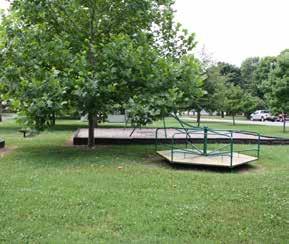
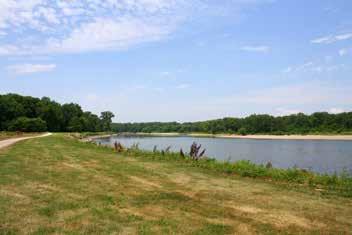

This goal addresses the improvement and renovation of the town’s parks facilities and equipment. Some of the features in the town’s parks have aging amenities that will likely require updates to ensure safety, accessibility, and functionality.
This goal focuses on utilizing both the town’s parks and streets as vibrant spaces that reflect and celebrate the town’s historical and cultural identity. By integrating art installations, historical markers, and educational displays within the parks and throughout town, New Harmony can create experiences that connect visitors and residents with the town’s unique history. 2 4 3
Trails are an integral part of New Harmony’s parks system, offering residents and visitors opportunities to explore the town and engage in the outdoors. The goal aims to expand and enhance the town’s trail network, making it more accessible, enjoyable, and connected.

Develop an invasive species removal plan: Manage and eradicate invasive plants that threaten local ecosystems while promoting the use of native species to restore biodiversity and support local wildlife.
Develop a plan for new plant material: New plant material should be 80% native. Additionally, tree canopy should be maintained in town parks and root zones should be protected during all new park improvements.
Ensure dark sky compliance: Reduce light pollution by using proper outdoor light fixtures that minimize glare and direct light where needed.
Renovation of Existing Facilities: Assess current park facilities to identify areas for repair or renovation. Focus on upgrades that enhance safety and functionality, using durable materials to reduce long-term maintenance costs.
Expansion of Park Amenities: Add new features based on community interests, such as splash pads, dog parks, trails, and playgrounds.
Renovation of Play Equipment and Park Amenities: Replace outdated playground equipment with inclusive, nature-inspired designs that cater to children of all ages and abilities, while ensuring safety standards are met. Ensure that a park maintenance list is used to determine maintenance efforts, and if necessary, funding strategies.
Enhancing Park Accessibility: Improve accessibility with more paved pathways, ramps, and accessible seating. Upgrade restroom facility entry.
Expansion of Trail Networks: Identify opportunities to expand existing trails, connecting key areas of the town and creating new routes that highlight natural and cultural landmarks. Emphasis will be placed on multi-use trails for walking, biking, and golf-cart use, which is popular throughout town.
Enhancement of Trail Amenities: Add features at trailheads to improve user experience. Educational signage about local wildlife and historic sites should be installed.
Develop a Cultural or Historical Town Route: Study a route throughout town that can be used to identify cultural, historical, and natural amenities. This route could be similar or identical, to the existing tour routes. However, this “trail”, or route would identify important features beyond the physical manifestation of historical features found in New Harmony today.
Historical and Interpretive Signage: Develop and place interpretive signs throughout parks and the town to highlight significant events, people, and landmarks from New Harmony’s history, enhancing citizens’ and visitors’ understanding of the town’s heritage.
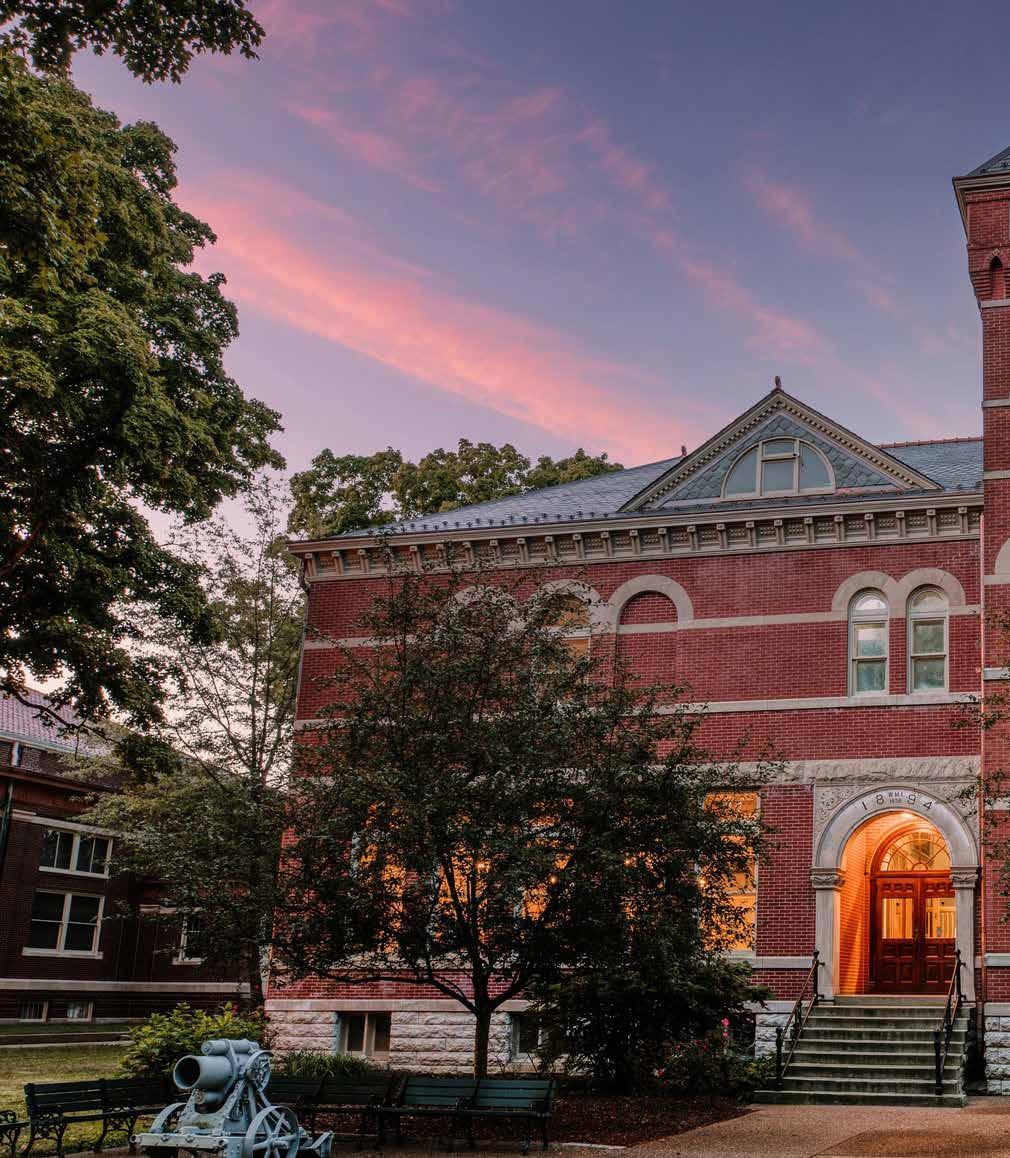
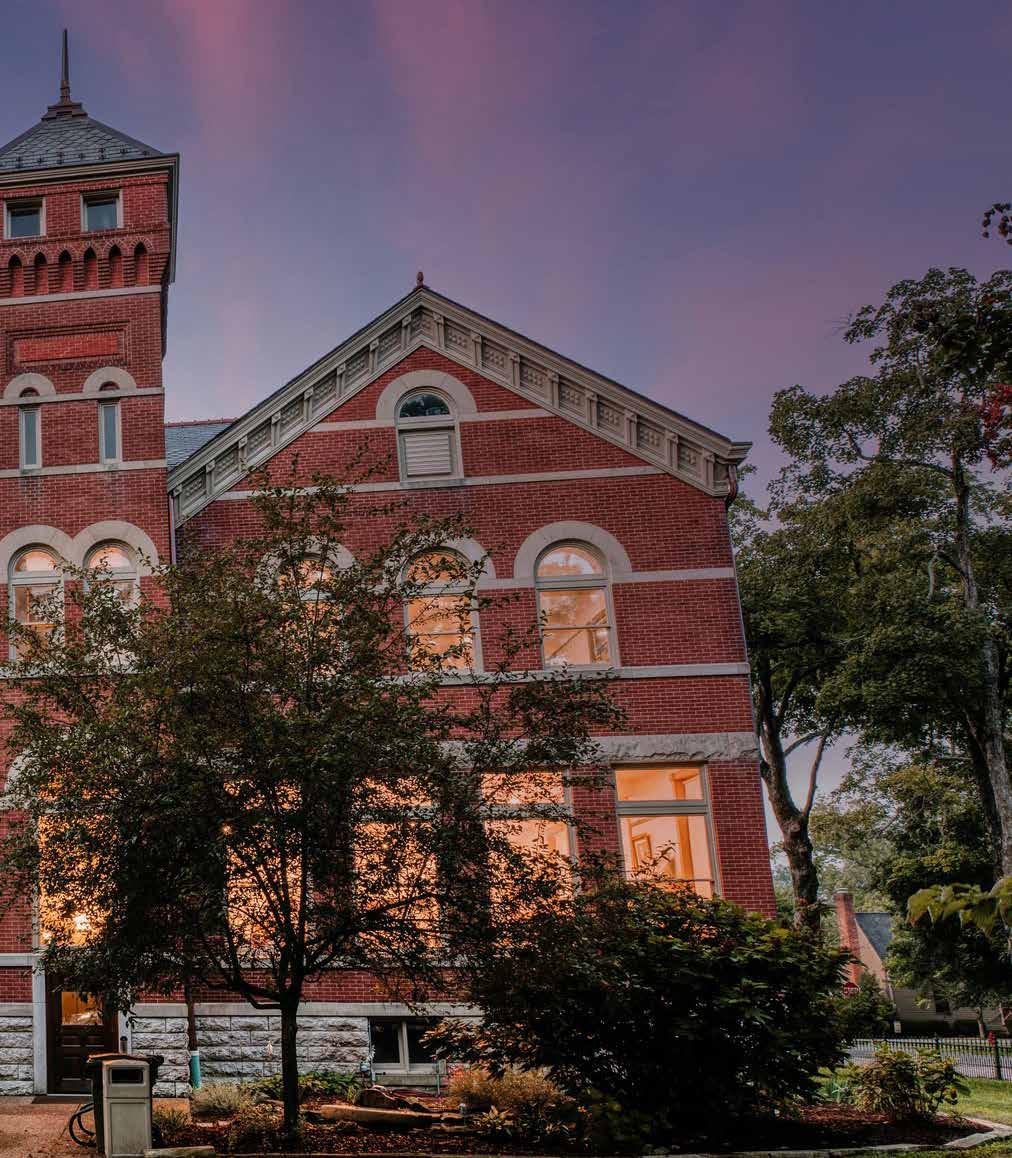
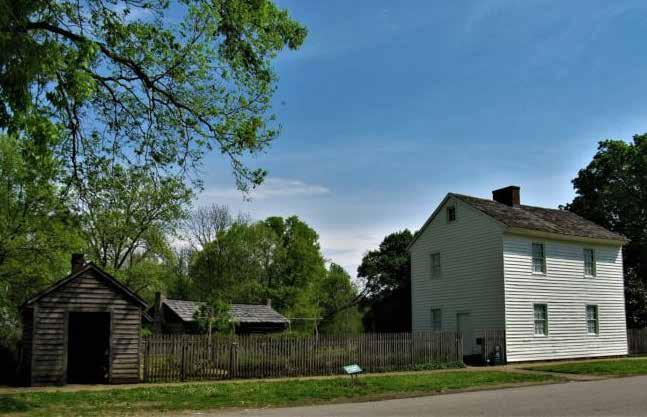
New Harmony, Indiana, is a small town with a rich and unique history, known for its two utopian communities (1814-1827) and its contributions to science, education, and social reform.
New Harmony was originally established in 1814 by a group of German immigrants led by George Rapp, a religious leader of the Harmonie Society. The Harmonists were a religious group who practiced a type of Christian communal living. They sought to create a society free from corruption and materialism, emphasizing equality, celibacy, and communal ownership of property. (New Harmony Then and Now)
George Rapp and his followers first settled in Pennsylvania, where they founded the town of
Harmony. After ten years, they relocated to southwestern Indiana, purchasing 20,000 acres of land along the Wabash River, where they built the town of New Harmony. The Harmonists developed a community that included mills, farms, vineyards, and industries.
Despite their success the group followed biblical prophecy and decided to sell their land in 1824, and moved back to Pennsylvania. (New Harmony Then and Now
In 1825, the Welsh industrialist and social reformer Robert Owen purchased the town of New Harmony from the Harmonists for $135,000, with the intent of creating a new type of utopian society based on “equal education and equal social status.” Owen’s vision for New Harmony was unique for its time. He envisioned New Harmony would be a “super social,
intellectual, and physical environment,” free from religious opinions and the inequalities of capitalism. (The Original Boatload of Knowledge Down the Ohio River, Donald Pitzer, University of Southern Indiana; Historic New Harmony, University of Southern Indiana)
Unlike the Harmonists, who were united by their religious faith, Owen’s community attracted a diverse mix of individuals, which were described as “a heterogeneous collection of Radicals, enthusiastic devotees to principle, and honest latitudinarians, and lazy theorists, with a sprinkling of unprincipled sharpers thrown in.” Disagreements among community members, lack of leadership, and practical difficulties led to the community’s dissolution by 1829. (Robert Owen, Pioneer of Social Reforms)
Owen’s experiment lasted only a few years, but its influence on American social and educational reform was profound. (New Harmony Then and Now; Historic New Harmony, University of Southern Indiana
Although both utopian experiments ultimately dissolved, New Harmony remained an important center for intellectual and scientific efforts throughout the 1800s. Many of the individuals who had come to the town during the Robert Owen period remained, contributing to its legacy in the fields of geology, education, and social reform.
One of the most notable people associated with New Harmony was William Maclure, often referred to as the father of American geology. Maclure was instrumental in founding the Working Men’s Institute (WMI) and establishing educational institutions that emphasized handson learning and scientific exploration. Today, Maclure Park is named after him.
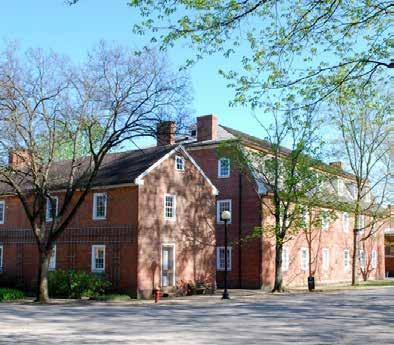
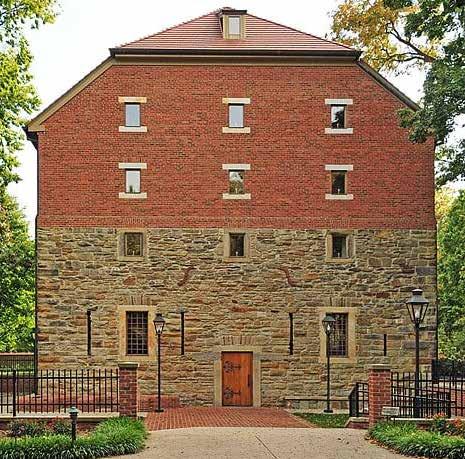
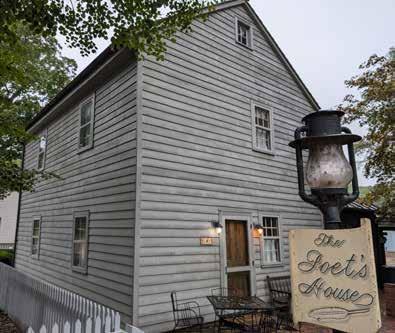
Other prominent residents included Thomas Say, an entomologist and naturalist, who made significant contributions to the study of insects, and David Dale Owen, Robert Owen’s son, who became the first state geologist of Indiana and helped survey much of the Midwest. (New Harmony Then and Now)
After Robert Owen’s social experiment, New Harmony evolved into a traditional rural town. Its residents continued to value education and intellectual pursuits, with institutions such as the Working Men’s Institute, the oldest continuously operating public library in Indiana, becoming an important town landmark.
The town’s unique history has continued to attract many visitors and scholars over the years. New Harmony was designated as a National Historic Landmark District in 1965. (2008 New Harmony Comprehensive Plan)
It is important how the parks of New Harmony respect the historical landmarks in the town. Adjustments or modifications to the town’s parks should always consider this relationship. However, the rich historical past of the town could be further celebrated in the town’s parks and could serve as a catalyst for how and why the parks could be improved in the future.
Jane Blaffer Owen (1915–2010) was a philanthropist, preservationist, and cultural visionary who played an important role revitalizing New Harmony. It may be said that a third utopia can be attributed to the progress made in New Harmony during her life. She became involved with the town after marrying an Owen descendant. Her passion for history, the arts, and spiritual reflection shaped her vision for the town, which she transformed into a center of cultural preservation and intellectual achievement. (www.visitnewharmony.com, A Life of Harmony, Stephen Fox)
One of Jane Owen’s most significant contributions was her commitment to preserving New Harmony’s historic buildings and landmarks, many of which dated back to the town’s early settlements. In the early 1800s, many of these structures were in poor condition and there was risk that the town’s unique historical identity would be lost. Jane Owen led an effort to restore key buildings beginning with Harmonist houses.
She worked with architects and historians to ensure that the restorations were appropriate to the town’s original design while also updating them for modern use. This preservation work not only protected New Harmony’s legacy but also helped turn the town into a destination for scholars and artists interested in its utopian past.
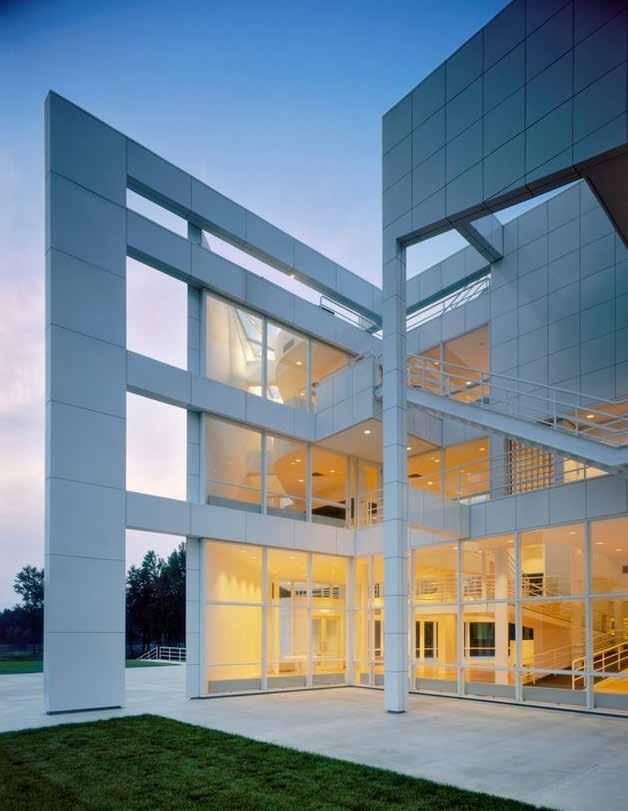

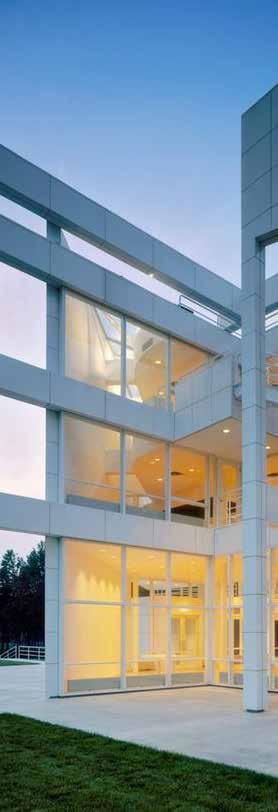
“Jane Owen moved beyond thinking about the renewal of New Harmony in antiquarian terms to conceive its restoration as a modern spiritual utopia, combining the religious and progressive projects of Georg Rapp and Robert Owen.” She supported and collaborated with artists, architects, and musicians, bringing creative projects to the town. One of her most notable accomplishments was with architect Philip Johnson, who designed the Roofless Church, an outdoor space symbolizing spiritual openness.
“Johnson’s concept was that only one roof—the sky—can encompass all worshipping humanity.”
(Art Institute of Chicago; A Life of Harmony, Stephen Fox)
In addition to the Roofless Church, Jane Owen helped establish the Cathedral Labyrinth and Carol’s Garden (Lawrence Halprin designed).
She was also interested in education and helped found the Robert Lee Blaffer Foundation (named after her father), which supported various cultural and educational initiatives in New Harmony.
Under her leadership, New Harmony became a gathering place for individuals who explored topics ranging from art and religion to science and social progress. (A Life of Harmony, Stephen Fox & Purdue University 2008 Honorary Degree)
“It’s said that her legacy may also be found in the faith she demonstrated, the friendships she forged, the beauty she created, the enthusiasm she espoused, and the simple way in which she lived.”
Today, New Harmony remains a place where history, art, and spirituality come together, largely due to Jane Owen’s vision and generosity.
(www.robertleebafferfoundation.org)
New Harmony’s history is a testament to the desire to build better societies. Though the utopian experiments of the Harmonists and Robert Owen were short-lived, they left a lasting impact on American thought, particularly in the areas of social reform, education, and scientific inquiry. Now, the town serves as a living museum, where visitors can explore it’s fascinating history and ongoing cultural contributions.
(www.visitnewharmony.com)
The town hosts a variety of festivals and events throughout the year that celebrate its unique heritage, arts, and natural beauty.
Held every September, Kunstfest is New Harmony’s largest annual festival, celebrating the town’s German heritage with traditional foods and crafts. Visitors enjoy live music, dancing, and unique crafts from local vendors.
A summer event celebrating firefly season, this festival includes family-friendly activities, live music, and educational sessions about the local environment. The Say Firefly, the Indiana’s state insect, is named after Thomas Say. Say lived in New Harmony and is considered the father of American entomology, which is an example of how the town still celebrates it’s intellectual history today.
(www.in.gov/dnr/entomology)
Typically held in the spring, this event focuses on hands-on demonstrations of traditional arts and crafts from New Harmony’s early days. Activities include weaving, pottery, blacksmithing, and more, attracting history enthusiasts and school groups
A celebration in early December, this event decorates the town with holiday lights, parades, and includes holiday markets featuring crafts and seasonal products.
During the July 4th celebration, songs are played at the Atheneum, the Declaration of Independence is read, and a keynote speaker addresses attendees. This event is organized by the WMI and Historic New Harmony. Afterward, the event moves to Maclure Park where attendees can enjoy food and patriotic music.
Throughout the year, New Harmony hosts various music and arts events, including outdoor concerts, art shows, and rotating exhibitions in the town’s galleries and parks. These events celebrate local and regional artists and performers. For example, First Brush of Spring Paint Out is organized by the Hoosier Salon and attracts plein-air artists from around the country to paint New Harmony’s scenic views. Artists create and sell their works, and the event includes workshops and demonstrations.
These festivals and events highlight the town’s dedication to community, culture, and the arts.
(www.visitnewharmony.com)
The Town’s modern-day success with festivals results in periods of peak demand for the park system, followed by times of lesser use. However, the tourist economy of the town results in visitors from Spring through Fall, potentially placing more demand on the park system than expected from a town of 690 residents. The seasonal and tourist attraction of the town should be considered in park maintenance plans.
New Harmony has a variety of natural resources that define its landscape, vegetation, and environmental conditions.
Topography
New Harmony is located adjacent to the Wabash River, which includes low-lying floodplains, rolling terrain, and flat to slightly hilly landscapes.
The elevation of New Harmony is relatively low, averaging approximately 400 feet above sea level.
FEMA FIRM maps indicate areas of the town are within the 100-year floodplain, of which Maclure Park is included. Murphy Park falls outside the 100year floodplain.
(FEMA FIRM maps, www.msc.fema.gov)
The soil composition around the town is primarily alluvial, deposited by floods of Wabash River. These type of soils are well-suited for agriculture, especially corn, soybeans, and wheat.
Common soil types in the region include loams, silt loams, and clay loams. In areas with higher clay content, drainage can be an issue, making these soils prone to water retention and compaction.
Maclure Park is almost entirely OnA (Onarga fine sandy loam), and Murphy Park is a mix of EkA (Elkinsville silt loam), As (Armiesburg silt loam), and Ha (Haymond silt loam).
(USDA, www.websoilsurvey.com)
The natural vegetation of the area was originally bottomland hardwood forests, typical of floodplains in the Midwest. Tree species would have included oak, hickory, sycamore, maple, cottonwood, and willow.
Much of the original bottomland forests has been cleared for agriculture and development, though pockets of woodlands and wetlands still exist around the town. Some areas, particularly along the river and in low-lying areas, remain forested (Harmonie State Park). (author site visits and observation)
The Wabash River was the primary reason for the settlement of New Harmony and has been both friend and foe to the town throughout its existence. The flood of 1913 was one of the area’s worst and imparted large scale destruction. Floodwaters reached as far as Main Street in the heart of New Harmony.
The Wabash was also a major channel for transporting goods and crafts to and from New Harmony over the years.
Much of the Harmonists’ success in commerce is attributed to the river. The Owenites also used the river for navigation and recreation including several ferryboats that traveled along the Wabash River. These boats were a primary means of transportation during the early 1900s (prior to the construction of the New Harmony Bridge in 1930) and ferried materials, equipment and people during this time.
Wetlands: Due to its location in a floodplain, New Harmony is surrounded by wetlands and low-lying areas. (2008 New Harmony Comprehensive Plan)
New Harmony experiences a humid climate, typical of much of the Midwest. Summers are hot and humid, with average high temperatures between 80°F and 90°F. Winters are cool to cold, with average low temperatures in the 20s and 30s °F.
The area receives an average of 45–50 inches of precipitation annually, most of which falls during the spring and summer months in the form of rain. Snowfall is typically moderate in winter, with around 10–15 inches of snow annually.
The growing season is long, lasting around 180–200 days, making the area well-suited for agriculture. The high humidity during the summer months can lead to challenges such as heat stress for plants. (www.bestplaces.net/climate/newharmony)
Interstate 64 is six miles north and the town is connected to the interstate system via SR69. The town is also connected to SR68 and SR66 via SR69.
Currently, the existing bridge that connects Church Street to Illinois is closed, and has been closed since 2012. There are efforts to re-open the bridge, but there is no established timeline for a reopening to occur. It is important to note that the New Harmony Bridge has never been owned, nor operated by the town. It was only after 2020, that US Congress passed legislation to allow an Illinois and Indiana Commission to study the reopening of the bridge.
The town scale allows for walkability to most of the historic and cultural landmarks. However, due to the higher median age and compact size, golf cart usage is common and encouraged throughout the town, with the exception of usage on Church Street which is under the control on INDOT. Golf cart and automobile parking is shared throughout town, and both need to be considered when planning for the future of parks and recreation for New Harmony. Sidewalks are present on most town streets, but new or renovated sidewalks could be
considered given the older mendian age of New Harmony. Likewise, older strom infrastructure at intersections and along sidewalks, including storm inlets, may need replaced in the future to ensure the towns remains walkable.
The relationship between the FEMA 100-year flood map and the town’s parks could dictate what can or cannot be programmed in the different parks. Maclure Park falls within the 100 year floodplain, whereas Murphy Park does not. It is important to note that the town is having on-going conversations with FEMA regarding the boundary of the 100 base-flood-elevation. Adjustments to the floodplain may impact how the town parks are developed, or maintained. The flood limits do not have a noticeable impact on the soil conditions or vegetation in the park - there are no noticeable areas of standing water.
Both parks have had a purposeful incorporation of a variety of shade trees. The climate of New Harmony allows for the use of trees and shrubs that may be more associated with use in Kentucky or Tennessee. Both parks, but especially Murphy Park, have plenty of shade trees and offer a cooler microclimate during hot summer days. Some minor areas of Murphy are more difficult to grow grass due to the heavy shade. The parks do not have any noticeable issues with invasive species, as this is more typical for areas around the town maintained trails, especially the trail that overlooks the Wabash River and is in the floodplain.
Access to the Wabash River is best through an IDNR owned and maintained boat launch near the closed New Harmony Bridge. The Wabash River is the longest river in the eastern United States that is undammed, which allows for kayaking, paddleboarding, and river activity to occur. The absence of low-head dams allows for safer use of the river. A DNR owned and operated boat launch reduces the maintenance efforts of the Town.
As of the most recent U.S. Census data, the demographics of New Harmony provide insights into its population, housing, and economic profile
Population
Total population: 690 residents. Age distribution:
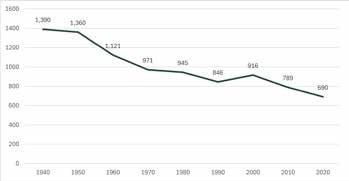
Median age: Around 50 years, reflecting a relatively older population.
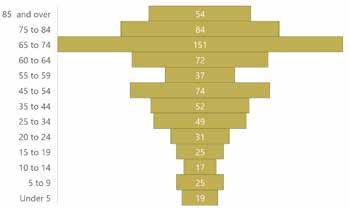
Breakdown by age group:
12.5% are under the age of 18
26.5% are between the ages of 45 and 64
42% are 65 and older
The town attracts retirees due to its quiet, historic atmosphere, and the proportion of elderly residents is higher than the national average.
Total households: Roughly 400-450 households. Family households: About 40% are family households, while the remaining 60% consist of non-family households, which includes individuals living alone.
Around 40% of households are comprised of individuals, and 25% of these have someone living alone who is 65 years of age or older.
Average household size: Approximately 1.95 persons per household, smaller than the national average due to the older population and prevalence of single-person households.
Owner-occupied homes: About 76%, reflecting a stable, long-term resident base.
Rental properties: About24%, indicating some degree of rental availability but limited compared to larger towns.
The town features a mix of historic homes, newer single-family homes, and a few rental apartments. The historic preservation in New Harmony makes housing here unique compared to other towns in the region.
Median household income: Approximately $45,000, lower than both the state and county’s averages. This reflects the town’s high proportion of retirees and older residents.
The economy of New Harmony is primarily driven by tourism (due to its historic attractions), local businesses, and agricultural presence. The town’s emphasis on historic preservation, arts, and culture creates unique employment opportunities in the hospitality and education sectors, but job availability remains limited compared to urban areas.
High School Graduation: The majority of New Harmony residents have at least a high school diploma, which is typical for many rural towns. The rate is generally in line with or slightly below Indiana’s statewide average.
Higher Education: While a smaller percentage of the population holds bachelor’s or graduate degrees compared to urban areas, New Harmony’s emphasis on cultural and historical education draws in residents and visitors who may have higher levels of formal education or interest in specialized fields like history, art, or architecture.

New Harmony is a small town with a predominantly older population. Its housing market is dominated by owner-occupied homes, and the average household size is smaller due to the higher number of single-person households. Income levels are less than the State average, reflecting the town’s rural character and the demographic makeup. New Harmony’s rich history and beauty contribute to its appeal, particularly among those seeking a quiet and historically significant place to live.
(www.census.gov, US Census Bureau, American Community Survey, 5-year estimates, analysis by author)
The most significant impact that the demographic information has on the town’s local parks is related to an older median age, compared to state and national averages. Park amenities should focus on accessibility to ensure access for older adults. Additionally, golf-cart usage is popular throughout town and golf-cart parking and usability should always be considered with future improvements.
However, meeting the needs of young families is still vital for a town that will continue to ensure that it is a place that all age groups can enjoy.
While the town has decreased population since 1940, the town has not physically decreased in size. It is not uncommon for some homes in New Harmony to be secondary, and the owners visiting during targeted times of the year. The town has the ability to maintain its current assets, but also benefits from organizations such as the University of Southern Indiana and the Indiana State Museums and Historic Sites to maintain the historic and contemporary landmarks within the Town. Targeted infill development or the reopening of the New Harmony Bridge may be the first step in stabilizing the decreasing population.
New Harmony may continue to leverage its relationships with various foundations to raise funds for future park projects, grant matching, and maintenance.
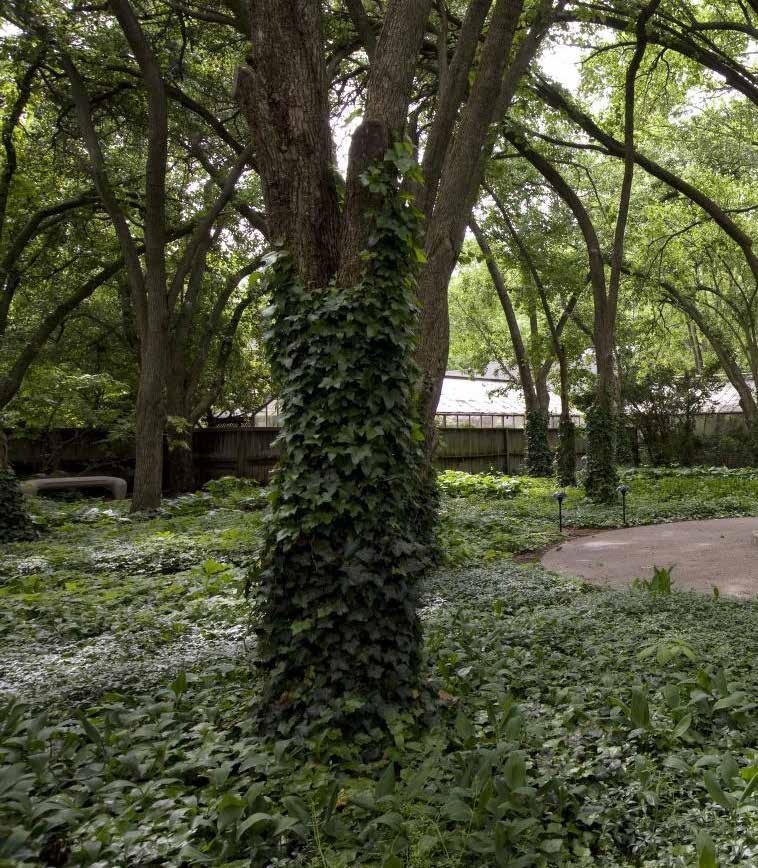
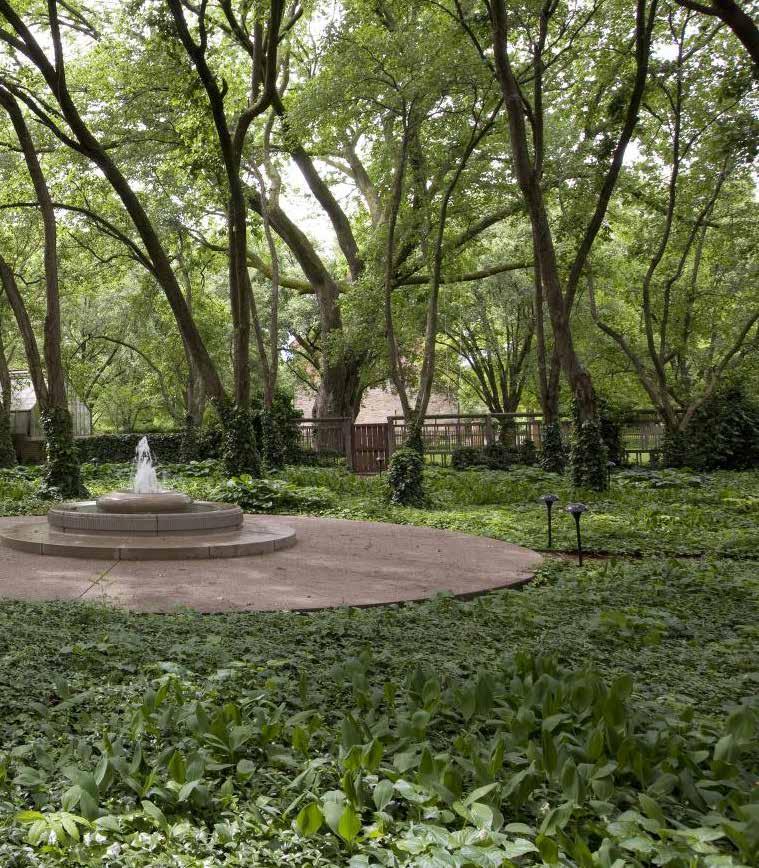
New Harmony, while home to just two parks (Murphy Park and Maclure Park) under ownership and management of the town, offers an array of open space assets that reflect its unique history. The town’s landscape is defined by public gardens, walking trails, and preserved historic sites that blend natural beauty with cultural heritage.
In an addition to the town parks, a number of historic and cultural assets are located throughout town, which are listed in the legend. While not under the operations or management of the town or specifically inventoried as part of the 5-year Parks Plan, the aforementioned historic and cultural assets of New Harmony are closely tied to the identity of the town’s parks, making them more than just green spaces—they are extensions of New Harmony’s unique character and history.
lupti reptiat
Murphy Park
Maclure Park
Town Trails
Atheneum*
Roofless Church*
Cathedral Labyrinth*
Harmonist Labyrinth*
Harmonist Cemetery*
Carol’s Garden*
Church Park*
RGE Tennis Courts*
Holy Angel’s Park*
Redbud Park*
Harmonie State Park (not pictured)*
Wabash River*
Maple Hill Cemetery (not pictured)*
Swan Lake*
Tillich Park*

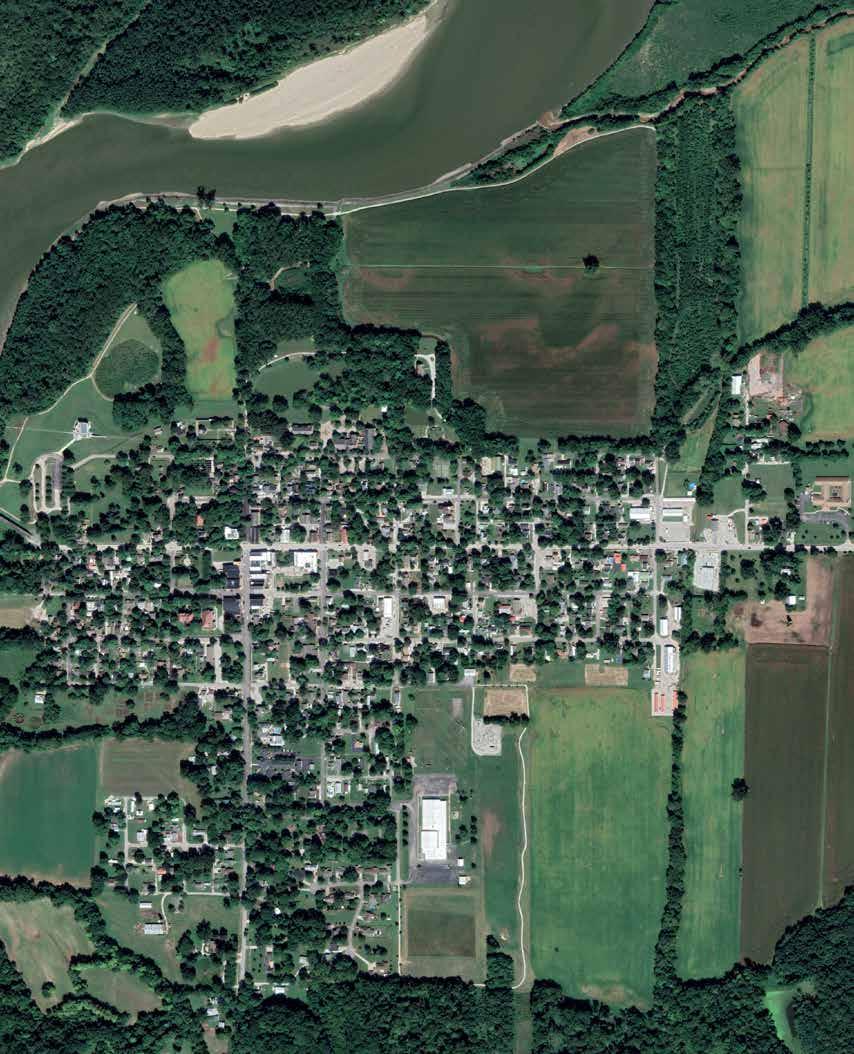
1014 Main Street
Murphy Park is one of the central open spaces in town, offering locals and visitors a peaceful, scenic retreat. Known for its welcoming, family-oriented atmosphere, Murphy Park serves as a hub for outdoor activities, and leisurely relaxation. The park is approximately 7 acres and offers a mix of large shade trees, shelters, and playground equipment, most notably Playtopia. Murphy Park is surrounded by Park Avenue to the north, Main Street to the west, and East Street to the east. Residential homes boarder the south boundary of the park. These homes are served by Parkview Drive.
Murphy Park is organized around a perimeter road that connects all of the amenities within the park. The perimeter road is asphalt and serves vehicles, including campers, golf carts, and pedestrians.
At the center of the park is Playtopia. Playtopia is a creatively designed playground with various play structures that encourage physical activity, imaginative play, and social interaction. The playground includes swings, slides, climbing structures, and interactive elements that appeal to children’s sense of adventure. Its layout is spacious enough to accommodate multiple families at once, allowing children to engage in a range of activities, from swinging and climbing to running and exploring.
Adjacent to Playtopia is an enclosed shelter, which can be rented for a variety of uses. The park also contains one other shelter, which is not enclosed. The open shelter is located on the east side of the park and near the Scout Cabin, which is used by Boy Scout Troop 386.
Murphy Park also includes restroom facilities. These facilities are showing signs of age and maintenance improvements are needed, which include woodbee damage on the soffit. These improvements
would ensure the popularity of the park, especially for those with young children. The restrooms are located within convenient access to all of the existing playground equipment and the enclosed cabin.
Other features of the park include more traditional playground equipment, a full-size basketball court, and a gaga pit (see images on the following pages). Large shade trees are located throughout the park, many of which are labeled with identification signs, including both the common and scientific names.
Murphy Park also includes campground sites with electrical hookups and picnic tables. The town just recently completed an effort that allows visitors to complete camping reservations online.
While the town maintains dawn-to-dusk hours for its parks, Murphy Park does have lighting along the perimeter road that serves all areas of the park.
Recently, the vacant school property east of Murphy Park was purchased. Future development of this property could increase housing, allowing Murphy Park to serve as a neighborhood amenity and potentially high-use possibilities.
Playtopia is designed to offer a variety of opportunities for children of all abilities. Some areas currently require maintenance to ensure that ramps remain flush to adjacent grade. Other playground equipment in the park requires accessibility improvements in order to access the equipment. (See photos on the following page)
In addition to the playground equipment (not including Playtopia), the entrance to the restroom facilities requires accessibility improvements. The existing surface is unlevel and appears to be too steep.

The Scout Cabin also lacks an accessible entry. Improvements should be made to allow for one or more of the entries to be accessible.



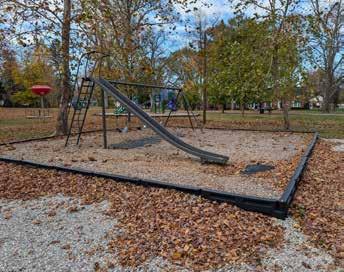


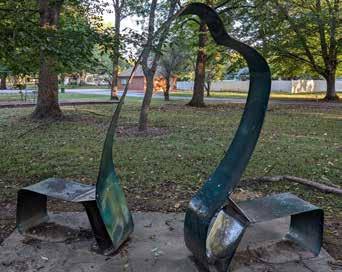
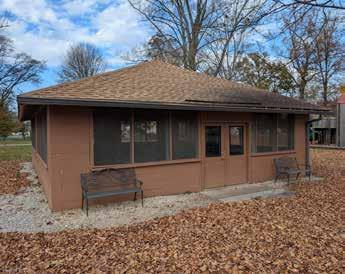
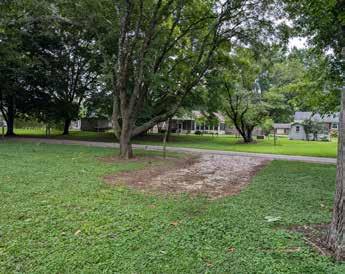


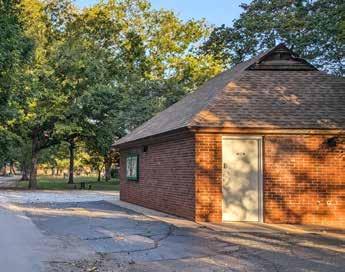
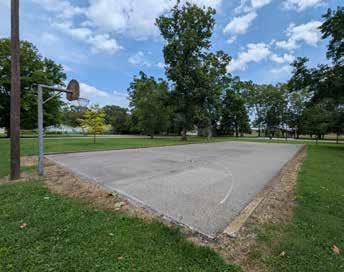
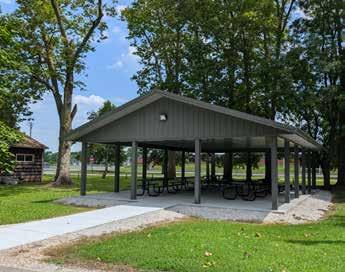
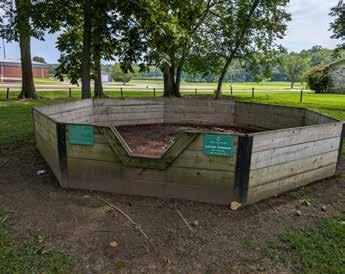
804 Church Street
Maclure Park is a community park named after William Maclure, a prominent geologist and philanthropist who was instrumental in the town’s early utopian experiment.
Maclure Park is located just east of the historic downtown and is approximately 1/2 acre. The park is surrounded by local streets on all sides; Granary Street to the north, Raintree Street to the east and west, and Church Street to the south. The parks location next to Church Street makes it a prime location and visible to those entering and leaving the town. On-street parking is available on each of the surrounding streets, with the exception of Church Street. The park includes a bandstand, playground equipment, and mature trees.
Each 4th of July, a celebration is held within the park. The event is organized by WMI and Historic New Harmony.
The bandstand has historical importance, as an older bandstand was once on site at the park. The current bandstand was dedicated on July 4th, 1975 from a gift of Laura E. and Carl A. Barrett for the Posey County Bicentennial Celebration.
The playground equipment is showing signs of wear. Most of the pieces are made from galvanized steel pipe fittings and need regular safety monitoring. While most of the playground has fall-rated mulch surfacing, the carousel lacks this safety feature.
The bandstand is in better shape than the playground equipment, with upgrades including electrical outlets. The trees in the park are in good condition, and new trees have been added to enhance the area.

Bandstand
Playground
Picnic Tables

Mature Trees


Accessibility improvements to access the existing playground equipment are needed. The equipment that is located within a fall-rated area is not accessible. The fall-rated material is raised above adjacent grade, and those with mobility issues may not be able to access the playground equipment. In addition, the carousel needs fall-rated safety surfacing.
There are no accessible pathways connecting the playground equipment to the existing sidewalk. Currently, sod separates the various equipment, and thus is not connected to the adjacent sidewalk.
The lower level of the bandstand is accessible, and the upper level is accessible via a set of stairs with handrails. The same opportunities for use are offered on the ground level of the bandstand as the second floor. Fall-rated surfacing is not required for the bandstand because it is not considered a piece of playground equipment. The recreational opportunities are equal regardless of what level is being used, and there are no specific programming that requires the use of the second floor. However, access to the bandstand could be improved, as an accessible route is not provided.
Playground Equipment & Drinking Fountain Bandstand
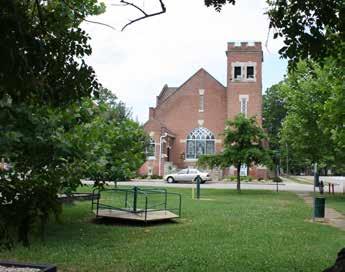
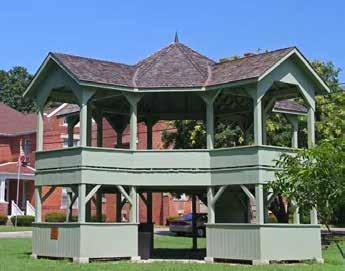
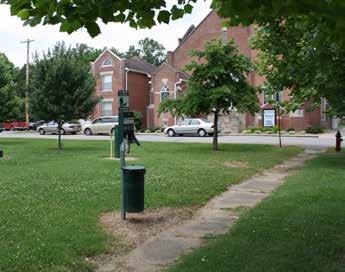
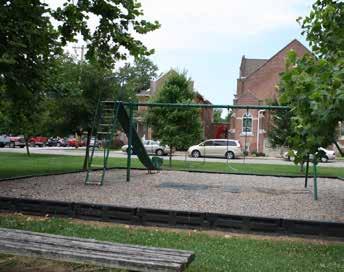

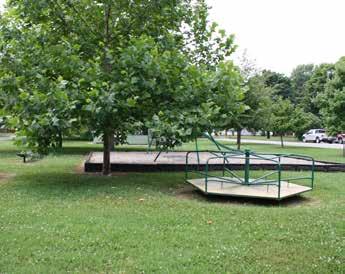
The trails along the Wabash River offer an opportunity for seeing the natural beauty that surrounds the town. Beginning with a gravel path that runs alongside the river, the trail takes users through woodlands and wetlands, eventually emerging at the intersection of Third and North Streets. From North Street, users can visit the historic downtown or continue south toward Murphy Park. During the spring, the Wabash River Trail is exposed to the flooding of the Wabash River, which may close or damage trail amenities.
On the south portion of town, a gravel trail circumnavigates the old New Harmony School property. This path is located along a wooded ridge, providing a scenic route that ends at the northeast corner of Murphy Park. From Murphy Park, users can access Main Street, where a short walk further south will lead to the Harmonist Labyrinth.
Each trail segment showcases the town’s mix of history and nature, with various landmarks, sculptures, and picnic spots along the way. Both trails are also a prime location for birdwatching, as the river and surrounding habitats attract wildlife.
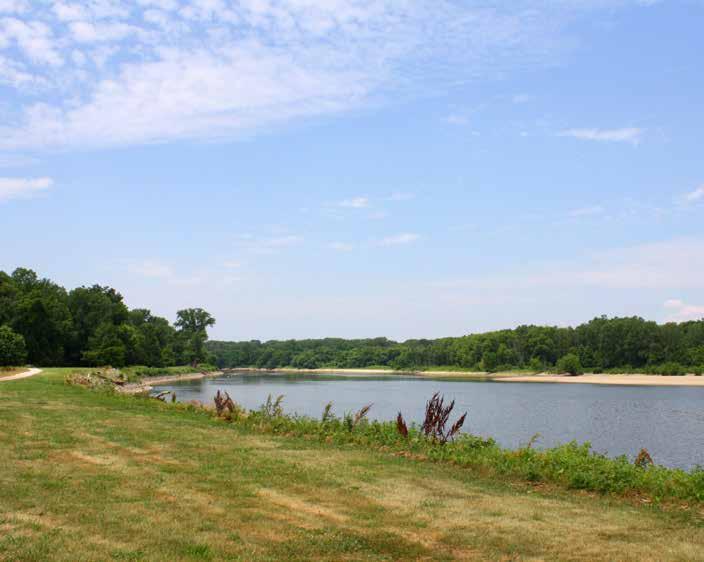
New Harmony is rich in cultural assets that are crucial to consider when developing the 5-year parks plan for Murphy and Maclure Parks. The town’s heritage as a utopian community and its longstanding dedication to art, history, and spirituality make it a unique destination. Key landmarks, including the Atheneum, Roofless Church, labyrinths, and historic sites, represent the town’s history that attracts residents and visitors. Murphy and Maclure Parks can serve as extensions of the town’s identity, culture, and history. Likewise, these cultural landmarks contribute toward the park and open space available to resident and visitors.
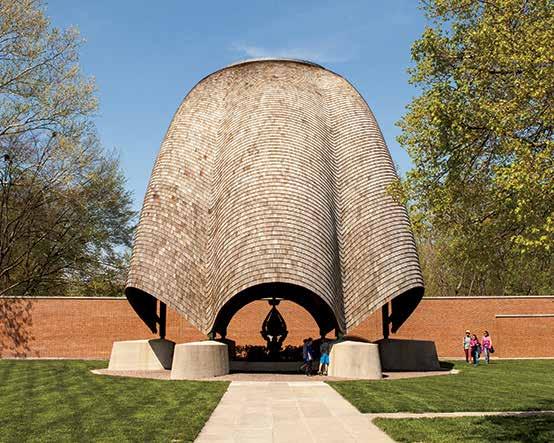
According to the US Census Bureau information collected in 2022, approximately 13.4% of the US population has a disability. Furthermore, 43.9% of people 60 or older within the United States have a disability. (cdc.gov) In a town that has a demographic profile such as New Harmony, accessibility and overall safety is imperative, especially within the park system. Parks are used by people of all ages and should offer comfort to those using the facilities.
In preparation of the plan, each of the town parks, Murphy Park and Maclure Park, were reviewed for accessibility. Specific barriers to accessibility for each park is specifically noted within the Existing Condition Inventory.
Accessibility issues within the parks typically are related to access to the equipment. Mulch is used for fall surfacing for playground equipment, which is an acceptable form of safety surfacing. The Town has installed edging to allow the mulch to be installed deep enough for falls. However, as with most mulch surfaces, washout and use around the playground equipment is typical and may impact its suitability. Secondly, the edging prevents those in wheelchairs or mobility impairments from accessing the playground equipment. Specific improvements, including accessibility, for each park are included in Section 05, Recommendations. Access to the playground equipment is also needed at Maclure Park. Sod separates all of the playground equipment and access pathways would provide a ways for those with mobility issues to use the equipment.
New Harmony does not have paid Parks staff or an ADA coordinator. In New Harmony, each Town Council member is responsible for a different aspect of the town:
• Economic Development
• Public Works
• Public Safety and Administration
• Streets and Streetscapes
• Parks and Recreation
Grievance procedures under the American with Disabilities Act shall be submitted to the following, who can also be contacted regarding ADA information:
Ann Huelsmann, Clerk-Treasurer
Town of New Harmony
P.O. Box 340
New Harmony, Indiana, 47631
• https://newharmony-in.gov/grievanceprocedure.php
• https://newharmony-in.gov/pdf/grievanceprocedure-10-2024.pdf
In addition to the park specific accessibility review, the plan asked for input from the general public to determined how successful accessibility is within the Town. Fifty-six percent of respondents said there were not accessibility issues, and another 40% said that they did not have disabilities that had an impacted access to public buildings or facilities.
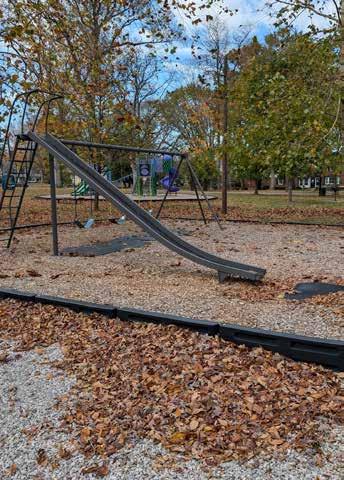


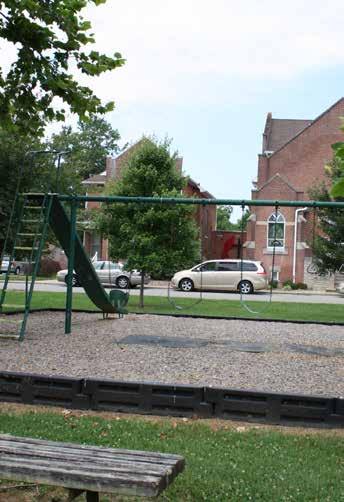
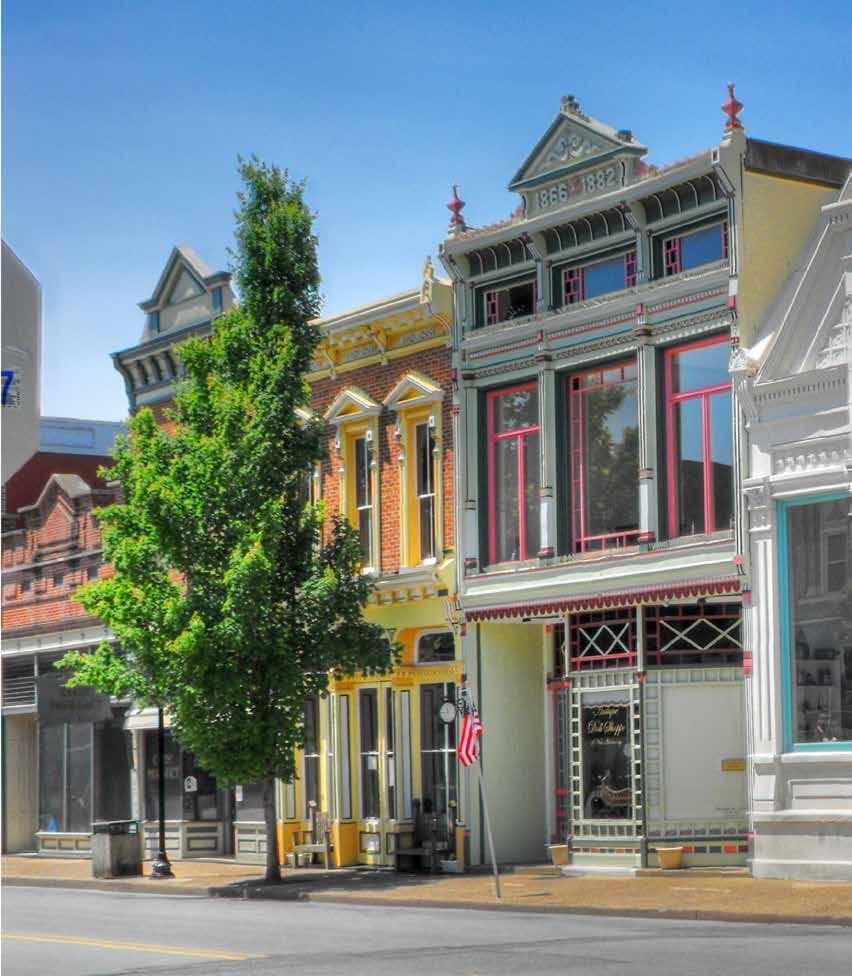

The purpose of a Needs Analysis is to determine the Level of Service (LOS) that should be considered for New Harmony, to ensure that recreational opportunities remain and adapt as the town grows or changes in the future. The New Harmony LOS standards provide a set of guidelines for park size and facilities needed to serve the Town.
The use of LOS standards does not require fulfillment but rather offers guidelines that a community provides its residents to ensure quality of life and equitable access to green and open space.
Given the historic size of the Town of New Harmony, changes are unlikely to the LOS guidelines provided. Likewise, the number of fulltime residents compared to those who own second homes or only live in New Harmony part-time, these guidelines should be monitored as the Town develops or changes over time.
It is important to note that New Harmony has more park and open space facilities than what is noted in the LOS study. For example, the following features are available to Town residents but are owned by state owned organizations or in some cases owned privately:
• one basketball court
• one tennis court and one pickelball court
• indoor pool (membership required)
• natural areas
• meditation spaces (gardens and labyrinths)
• boat launch (DNR owned)
• trails
These additional recreational offers are not considered in the LOS guidelines because they are not owned by the Town of New Harmony. However, most are owned by organizations that are also invested in the success of the town. While this consideration may be similar in other towns, New Harmony is unique due to its history and number of organizations offering recreation facilities to the town (University of Southern Indiana, Indiana State Museum and Historic Sites, Blaffer Foundation) compared to its population.
The use of LOS standards for park and recreation facilities is based on national trends in the National Recreation and Park Association (NRPA) 2024 Agency Performance Review, which was utilized to help establish a benchmark of outdoor facilities. The Indiana Statewide Comprehensive Outdoor Recreation Plan (SCORP) recommends the usage of the NRPR benchmarking report that “allows communities to compare ‘apples to apples’ by taking community information gathered from similar communities, and comparing it directly.”
Given New Harmony’s population and nationally unique history, using the NRPA guidelines provide a broader baseline sample than a town-to-town comparison.
New Harmony Parks manages 7.52 acres of parks for 690 residents, which is the current population of the town. The plan’s recommended LOS standard is 12.6 for every 1,000 people, or 10.89 acres for the
Town’s population of 690. The town falls just short of this guideline, which provides 7.52 acres in total of park space between Murphy Park and Maclure Park. The town owns additional property that could become a park (1.0 acre), and the plan considers this in the recommendations section. However, when considering the park and recreation facilities offered by other owners, the guidelines would be satisfied. The following assets within the town contribute additional park space:
• Church Park (1.1 acres)
• one basketball court
• Red Geranium Restaurant and Conference Center tennis and pickeball court (.6 acres)
• Cathedral Labyrinth (.25 acres)
• Harmonist Labyrinth (1.0 acres)
• Holy Angel Park (.75 acres)
• Red Geranium Restaurant and Conference Center woodland and lake (23.3 acres)
The total acreage would far exceed the LOS guidelines for the town given the significant amount of additional park and open space that contributes to the Town and available to the public. While additional amenities within the existing
Town parks could be considered, the total offerings is more than adequate when considering the Town as a whole. The plan acknowledges that properties not in the town control can change or be modified, but with the number of State maintained and historically owned property, this may be of less concern than typical privately owned property.
A second measurement guideline would be the one park per 1,100 residents. Using this threshold, the town would meet the LOS suggested.
The town currently manages 1.65 miles of gravel trails. The plan’s recommended LOS standard is .25 to .50 miles for every 1000 residents. According the NRPA the median miles of trail for a town of less than 20,000 population is 4.5 miles, with a range between 2.0 and 9.2. If this range is calculated per 1000 residents, the town would meet the threshold of the NRPA guideline.
In addition to the gravel trails managed with the town, trails along the Wabash River are offered to the public and operated by DNR, the University of Southern Indiana, and Red Geranium Inn and Conference Center, which would further increase the total miles of trails available to residents. (The plan does not include these privately owned trails in the measured data in the table.) The plan further examines additional trail opportunities based on feedback from the public.
According to NRPA 2024 Agency Performance Report, one playground is provided for every 2,000. New Harmony meets this threshold easily, with both Maclure Park and Murphy Park offering
playgrounds. The town may consider removal of some play equipment because the needs of the community are easily meet, and this could be a strategy to reduce future maintenance costs.
Murphy Park also has a gaga pit, but this is considered part of the overall play experience within Murphy Park.
New Harmony currently does not have a dog park, and for a town of its size, would not be expected to have one. The aforementioned NRPA report notes one facility per 10,000 residents. However, the town owns property next to the Sewage Treatment plant that has been identified as a potential location for this type of facility.
In addition the playground equipment, the town has a basketball court at Murphy Park. The town would meet the guideline for its single court, and this plan considers modifications to this court to allow it to be multiuse. Mulituse tennis, basketball, volleyball, and pickelball courts all fall within the range of one facility per 3,000 to 5,000 residents, suggesting that if the town were to consider changes to its existing court, it would continue to meet the guidelines for facilities.
Likewise, the addition of a spray plaza would be uncommon for a town of this size. However, this type of amenity would be a draw for young families and visitors during the various events and tours that draw visitors to New Harmony.
One of the most common amenities for parks are softball or baseball diamonds, which New Harmony does not have. While this could be considered in New Harmony, the maintenance efforts and lack of a
local school make the long term success of diamond fields unlikely.
The plan suggests a potential range for operational costs for the Town of New Harmony and one of the goals of the Parks Department is to help assist town officials with future budget planning.
In the table, the LOS guidelines median is $135 per person which would result in a parks budget of approximately $93,000 per year. Using the lower quartile of $75 per resident, the parks budget would be $52,000 per year, and using the upper quartile of $263 per resident would be $181,000 per year.
A second measurement technique is by total park acres. The NRPA benchmark identifies a median of $9,777 per acre for communities less than 20,000. Given the current size of the New Harmony park system, a budget would total $73,000 per year. The lower and upper quartile produce a much larger range, from $30,000 per year ($3,856 per acre) to $208,000 per year ($27,711 acre).
Using the median for both LOS guidelines suggests a park budget between $73,000 to $93,000 per year as a goal. The figure could be as low as $30,000 per year, which could be an initial benchmark to achieve in future budgets. It is suggested the town analyze their typical maintenance needs in addition to deferred maintenance to determine where they may feel most appropriate to fit within the guideline budgetary numbers above. Volunteer efforts, crowd-sourcing, and collaboration with the Indiana State Museums and Historic Sites, the University of Southern Indiana, and the Blaffer Foundation could also assist in reducing yearly maintenance costs. The town may consider forming a Parks Foundation to assist in receiving certain funds or grants for which the Town would not be eligible otherwise.
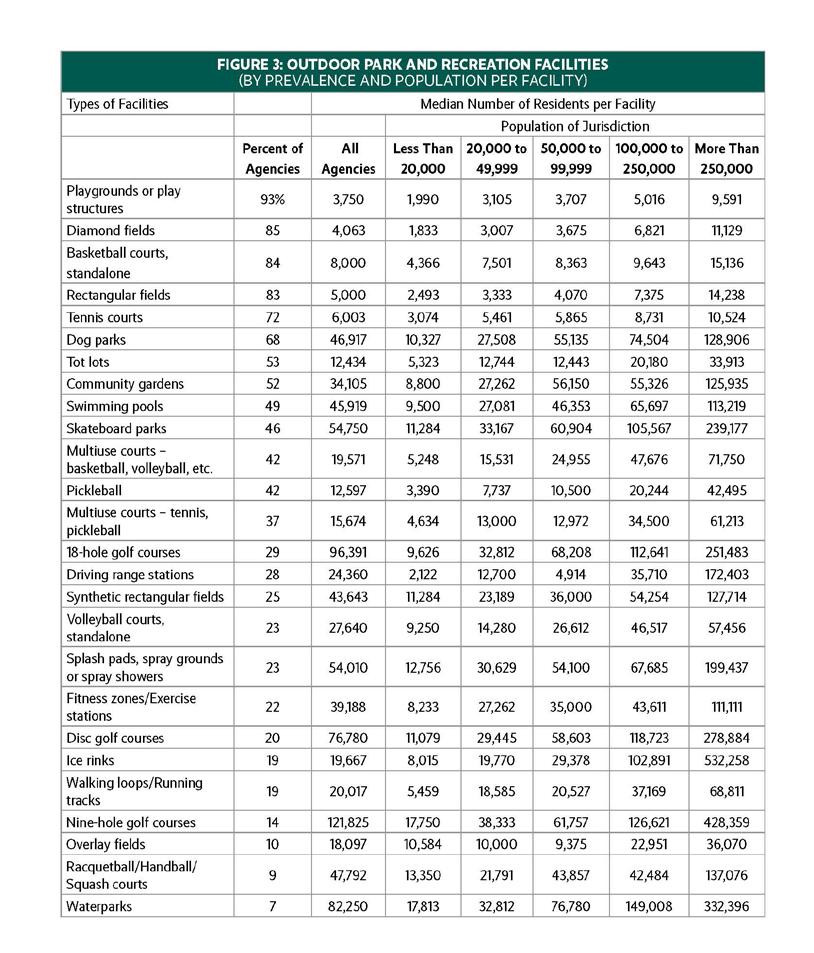
2024 NRPA Park Benchmarking Study, matrix of amenities per population
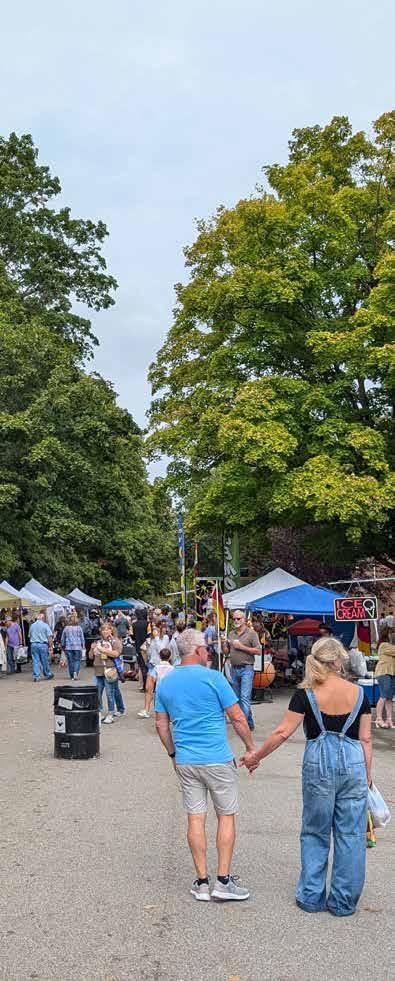
Location
Kunstfest 2024, booth at Church and Main
Dates: September 21
Number of Attendees:
Approximately 25-30 direct responses; conversions with many others also occurred
The parks in New Harmony play an important role in enhancing the town’s appeal to visitors, as highlighted during Kunstfest, where visitor input was gathered as part of the overall comprehensive plan update. Given the significance of tourism for the town’s economy, understanding visitor preferences for local parks and amenities is important.
Common feedback from visitors focused on the desire to reopen the Harmony Way Bridge, which has been closed since 2012. Opinions varied between opening it for vehicular traffic or pedestrian traffic. Additionally, visitors expressed a desire for more family-friendly dining options.
There was also considerable agreement for increasing or maintaining the number of community events, such as festivals and cultural gatherings. Many visitors cited Kunstfest as a reason why they would visit town.
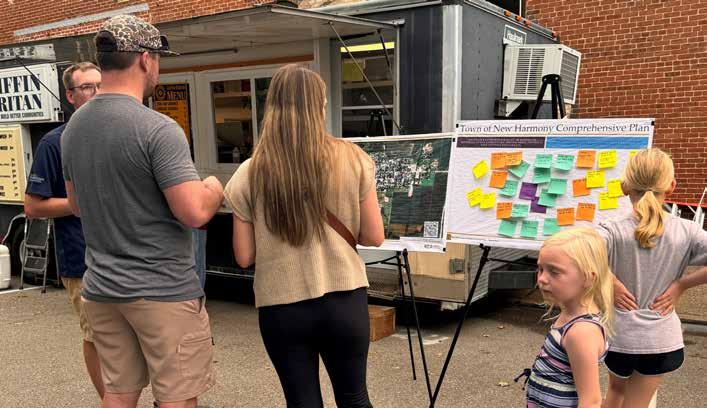
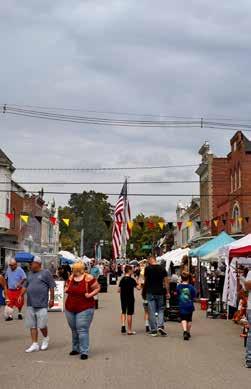
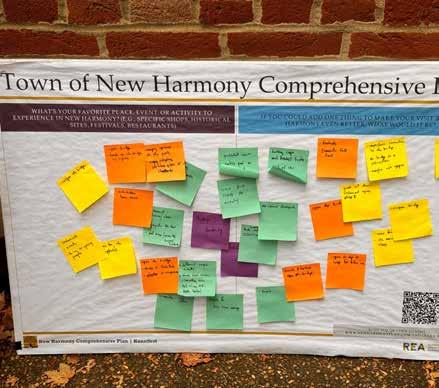
Location
Thrall’s Opera House
Dates:
September 30 and October 3rd, 2024
Number of Attendees:
September 30th: approximately 100 (14.4% of population). Total attendees does not include media, consultants, or elected officials of the town.
October 3rd: approximately 80 (11.5% of population)
Two public meetings were held to determine the vision and guiding principles for New Harmony’s long-term goals for sustainable growth and preservation. The public meetings were held to gather both input for the 5-Year Parks Plan and the Town’s updated Comprehensive Plan.
Key draft principles provided by the public are summarized below:
1. Protect and enhance New Harmony’s distinctive character, shaped by its unique assets, open spaces, natural beauty, and iconic places.
2. Ensure quality development that complements the scale of its surroundings and contributes to the vitality of the community.
3. Provide more housing to support peoples’ needs.
4. Support, enhance, and foster Main Street and Church Street as the vibrant commercial core of the community.
5. Enhance and cultivate New Harmony as a tourism destination.
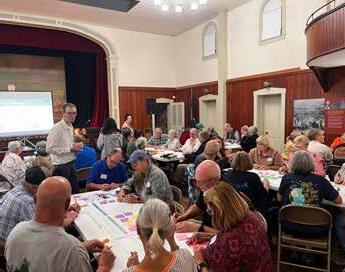
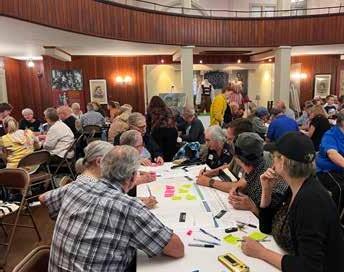
6. Maintain a sense of identity by defining the town’s edges with a transition from residential to agriculture or greenspace.
7. Manage change through incremental, thoughtful development.
8. Preserve quality green spaces, parks, areas of natural beauty, the tree canopy, and agricultural assets that contribute to the Town’s serene environment.
9. Pursue mitigation, conservation, and restoration strategies to maintain a resilient community, especially regarding the floodplain.
10. Upgrade and maintain infrastructure to support the well-being of New Harmony.
11. Ensure the design of buildings contributes to activating streets and public spaces
12. Emphasize active transportation for both destinations and recreation by connecting land uses through improved sidewalks, multi-use paths, and trails.
13. Support educational opportunities in New Harmony.
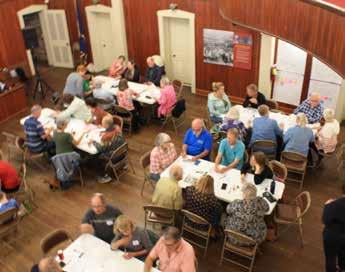
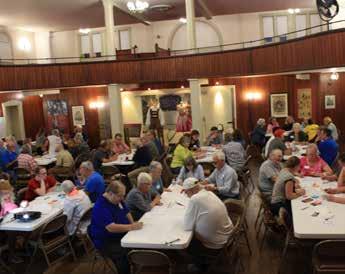
Dates:
August 27th through October 31st, 2024
Number of Attendees:
126 unique visitors
73 survey responses (10.5% of town population)
13. What activities do you most enjoy in your free time? Required Multi Choice | Skipped: 0 | Answered: 73 (100%)
1. What activities do you most enjoy in your free time?
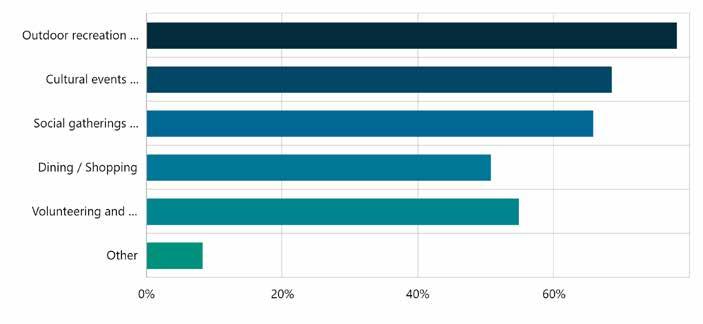
19. Do you experience any difficulties accessing public buildings, parks, or other community spaces due to mobility issues or other disabilities? Required Multi Choice | Skipped: 0 | Answered: 73 (100%)
2. Do you experience any difficulties accessing public buildings, parks, or other community spaces due to mobility issues or other disabilities?

The online survey was available for two months during the early planning process of the 5-Year Parks Plan. Respondents generally followed the same age demographic of the town makeup.
Residents of New Harmony appreciate the town’s peaceful atmosphere, historic charm, and strong sense of community, along with its natural beauty and manageable cost of living.
The following were important highlights from the survey:
1. Outdoor recreation, which included biking and hiking was the activity that most respondents enjoyed. This answer is noteworthy because it eclipsed even cultural events, for which New Harmony is widely known.
2. While existing accessibility issues were noted in the park assessments, respondents did not feel accessibility in public spaces had any negative impact on their use.
3. Respondents identified parks, trails, and recreational facilities as the second highest priority for improvements. New and repaired sidewalks and tree canopy was a close third. These results confirm that there is continued interest to invest in public spaces, when asked to consider the town as a whole.
4. The town’s parks, trails, and recreational amenities received high scores for overall quality. This is consistent with the results of survey question 1.
5. Environmental issues, such as flooding, was the highest concern among resident responses regarding concerns about the future of New Harmony. As noted in the Community Profile, sections of town fall within the FEMA FIRM map 100-year flood event.
Beyond specific survey questions, respondents were given the opportunity to provide written feedback. The following represents a summary of the feedback related to both the overall quality of life in New Harmony, and the town’s parks.
• Respondents recognize the economic benefits brought by tourism. However, there are concerns about the impact of tourism on the town’s character, a shortage of affordable housing, and a lack of resources such as faster internet and grocery options. Many respondents feel the town could lose its unique charm if future development is not diligent.
• Areas of park improvements focused on eliminating trip hazards within parks, replacing or adding benches in key areas in the parks, and improving sidewalks throughout the town.
22. Which areas do you think should be prioritized for improvement? Required Multi Choice | Skipped: 0 | Answered: 73 (100%)
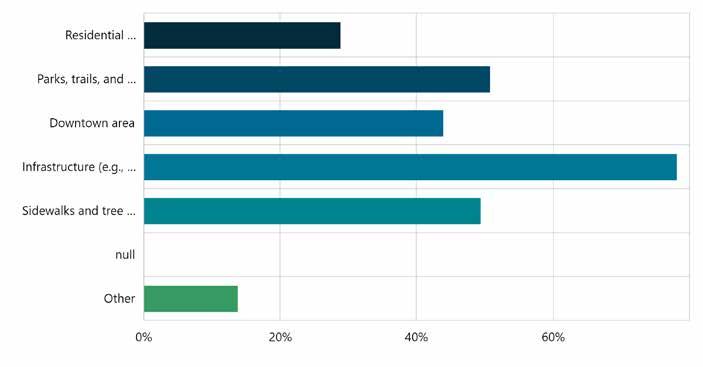
31. Parks, trails, and recreational facilities Required Rating | Skipped: 0 | Answered: 73 (100%)
Answer choices Percent Count
4. How would you rate the current state of parks, trails, and recreational facilities?


4. What is your age group? Required
| Skipped: 0 | Answered: 73 (100%)
5. What is your age group?
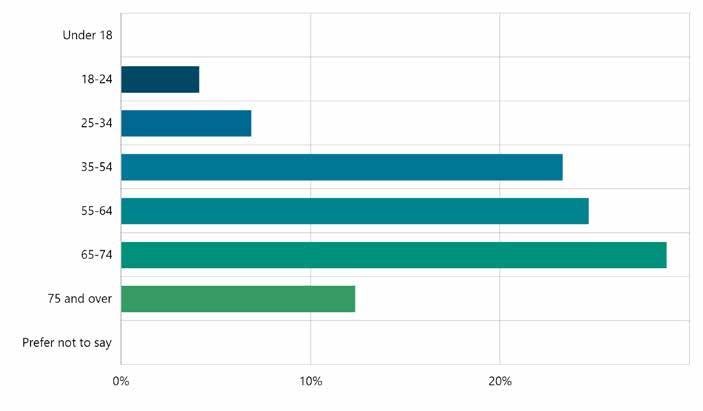
6. What specific concerns do you have about the future of New Harmony? Select all that apply.
18. What specific concerns do you have about the future of New Harmony? Required
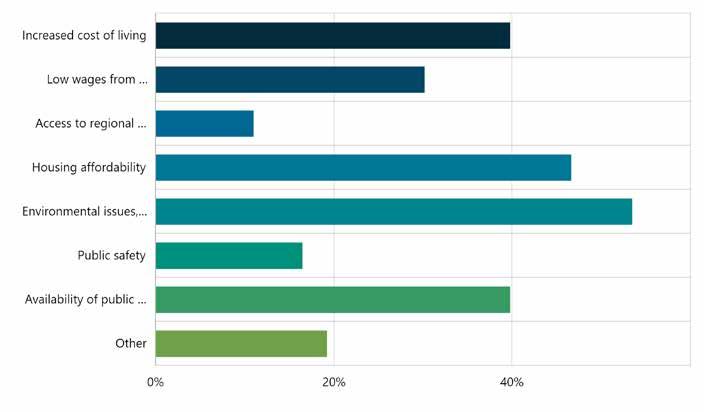
Location
Thrall’s Opera House
Dates: March 19, 2025
Number of Attendees:
March 19th: approximately 49 (7.2% of population)
Total attendees does not include media, consultants, or elected officials of the town.
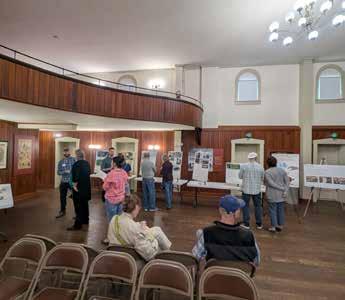
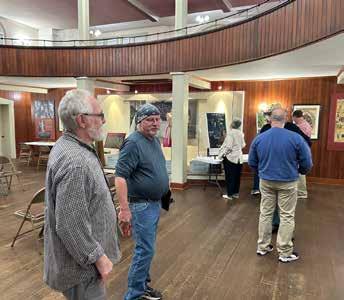
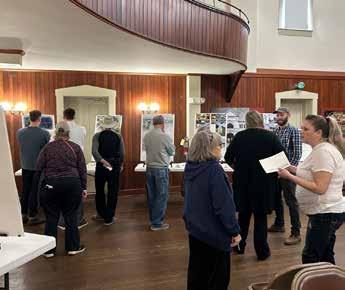
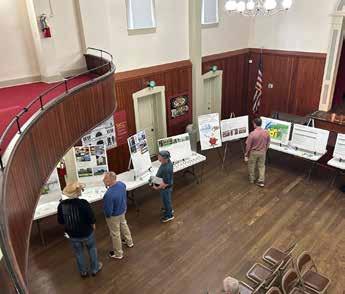
The proposed recommendations that were developed as objectives in the plan were presented to the public to determine the priority of future projects.
Each attendee was provided five coins to allocate toward the future master plan objectives identified. With 49 attendees, nearly 250 “votes” were cast, with total in the figure shown. Below are the percentage of total “votes” each future project idea received:
Trail to Harmonie State Park – 52 votes (21%)
Dark Sky Lighting – 40 votes (16%)
Dog Park – 26 votes (11%)
Maclure Park – 25 votes (10%)
Canopy Walk – 25 votes (10%)
Murphy Park – 21 votes (8.5%)
Planting Plans – 20 votes (8%)
Signage Improvements – 19 votes (8%)
Invasive Species Removal – 15 votes (6%)
The connection between the Town of New Harmony and Harmonie State Park was the most preferred recommendation, and the Invasive Species Removal Plan also received support. This indicates that there is some support for all of the objectives of the plan, and this data allows the Town to prioritize future projects and efforts.

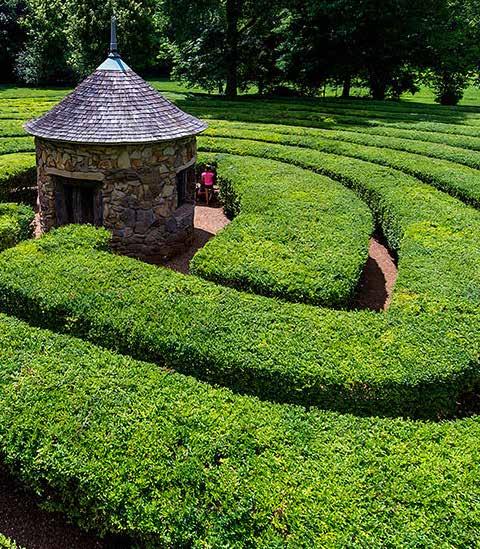
The overall strategy for long term planning at Murphy Park can be symbolized with the graphic describing the program from passive to active, west to east, across the park. The following is a list of recommendations for Murphy Park:
• ADA improvements to access the playgrounds west of the central shelter
• ADA improvements to access the restrooms/ storage building, and the Scout Cabin
• Mulch safety surfacing in areas under high-use in the playgrounds, such as swings, and in areas at the base of ramps
• Yearly maintenance budget for Playtopia
• Maintenance and improvements of restroom building, both to the exterior structure and the interior
• Improved parking areas near the existing restrooms and the existing eastern covered shelter
• Improvements of the existing basketball court to allow multiple types of active uses to occur (tennis, pickleball)
• Improvements to existing campsite, including grills and/or firerings
The improvements at Murphy Park are related to maintenance of the existing amenities in the park.
Maintenance improvements can be planned for with the annual Town operating budget and should be inspected yearly for continued compliance. Prioritizing maintenance may be required based on Town funding. The Town has shown the ability to crowdsource maintenance improvements, which has already occurred for Playtopia.
When improvements for the existing basketball court are planned, the Town may consider the adjustments of the court to be half basketball, half tennis/pickelball court. If there is a desire to locate a splash pad in Murphy Park in lieu of Maclure Park, the Muprhy Park master plan may need to be updated to ensure strategic planning of the park is strategic to the existing amenities and utilities.
The implementation of Dark Sky Lighting and Planting Plans for Murphy Park should be developed.
Entrance

Entrance
Possible Labyrinth
Camping Parking Parking
Restrooms
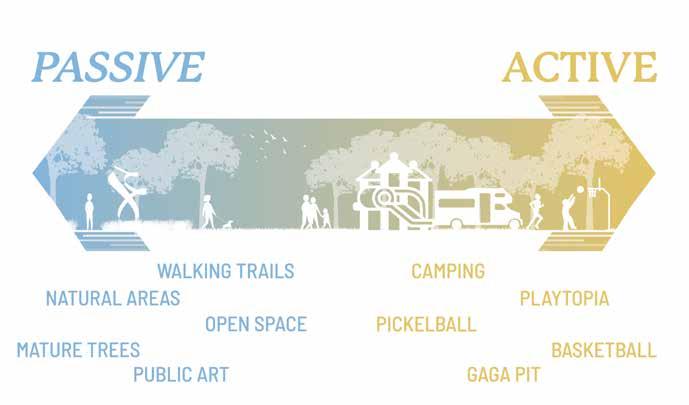
Short-term recommendations should focus on improving the accessibility of the playground equipment, as noted below. A long-term vision for the park looks to provide new playground equipment and a spray plaza. Potential improvements along Granary Street will slow traffic next to the park. Short term improvements should include the following:
• ADA improvements of existing play equipment
• Mulch safety surfacing in high-use areas of the playgrounds, such as swings, and in areas at the base of ramps
• Implementation of accessible pathways that connect the playground equipment and bandstand to one another and to the adjacent sidewalk.
Long term recommendations could explore the following:
• Continue to study and explore the master plan, including funding options, and specific
playground elements within the design.
• Implementation of master plan, including playground, spray plaza, and hardscape improvements such as plazas, curbs, and onstreet parking
The plan recommends celebrating the history of William Maclure, who lived in New Harmony and is considered the “father of American geology.” In addition to Maclure, there were several geologists who also lived in New Harmony, such as Richard Owen, the first president of Purdue University. The plan explores evoking the importance of geology in New Harmony and celebrating William Maclure, by recommending that the playground be redesigned as the “geologist playscape”, using natural features such as rock formations and tree logs.
The implementation of Dark Sky Lighting and Planting Plans for Maclure Park should be developed.
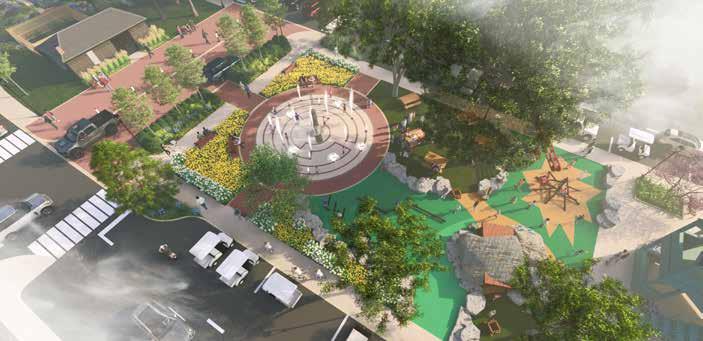
Granary St.
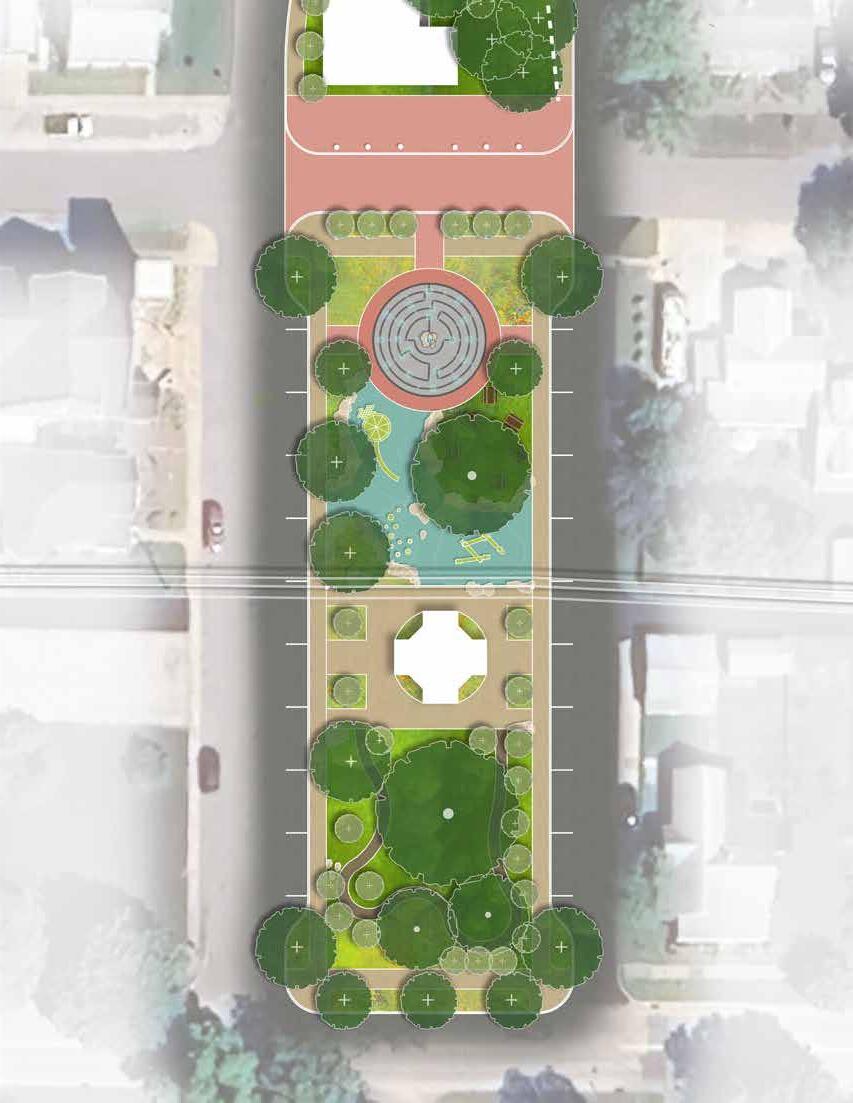
Raintree St.
Street Parking
Labyrinth
Splashpad
Geologist
Playground
Bandstand
Woodland Garden & Event Lawn
Street Parking
A connection between the Town of New Harmony and Harmonie State Park was the most preferred future project based on feedback provided during Public Meeting #3.
The purpose of this project would benefit both residents of the town and visitors of the State Park, allowing trail users to be directly connected and visit either location. It would also provide access to natural amenities of the area including the Wabash River and the Wabash Border Nature Preserve, which “contains one of the largest tracts of mature mesic upland forest” and “several rare fish species in Road Brook.” (www.in.gov/dnr/nature-preserves)
The proposed alignment suggested in the plan is preliminary and a more comprehensive study would need to be performed to understand topography and natural features, drainage, safety, and a detailed construction cost estimate. A preliminary study of landowners in the area show that various routes are attainable and may limit the number of landowners that are potentially impacted. Coordination with local landowners should be preformed before moving forward with an engineering study.
Coordination with IDNR and Next Level Trails funding may bring additional resources to the project.
OLD DAM RIVER CAMP
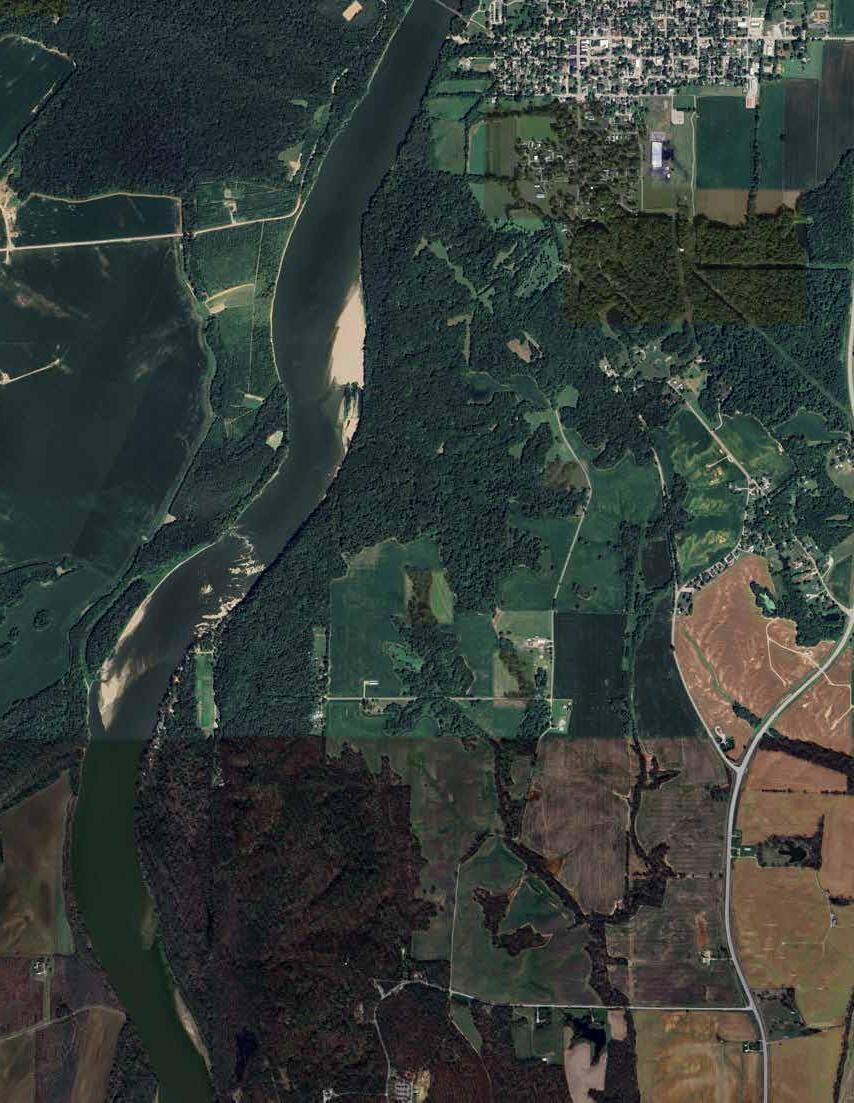
WABASH BORDER NATURE PRESERVE
In addition to either short term or long term improvements at existing Maclure Park and Murphy Park, new facilities may also be considered in New Harmony.
The dog park facility could be implemented in the short term, due to the relatively low cost of implementation and the town owns the property of the proposed dog park. Adding new amenities without displacing the existing tax base is also important in a small community.
Challenges related to the implementation of the dog park are mostly related to operation. Some park departments require vet records to be provided that demonstrate the animals are up to date on vaccinations. If New Harmony decides to pursue this option, more operational time is required. Key cards and key readers may be used to implement the policy. If these costs present a hardship for the town, an honor system could be used. Annual usage fees could be used to offset the costs of a digital card reader. However, in a small community such as New Harmony, this level of oversight may be difficult to manage.
In a effort to utilize the bottomland forest land adjacent to the area north of New Harmony, a proposed canopy boardwalk would allow residents and visitors the opportunity to utilize this space during flood events or during times of the year with the soil is saturated. The town could explore a variety of routing options utilizing the extension of the existing right-of-way, or exploring easement options with existing private property owners.
Existing assets that would be leveraged through a boardwalk improvement may include the following:
• Increased access to Wabash River, including for those with mobility impairments
• views to Roofless Church or Atheneum
• Utilization during the Firefly Festival. The Say Firefly is named after Thomas Say, who has been called the “father of American descriptive entomology and American conchology.” Say lived in New Harmony and carried out two “monumental works, describing insects and mollusks.” (Part 11, American Entomology)
Additional study of the routing and elevations of the canopy is suggested. If the routing study determines that an easement can be granted through a private property owner, this should be documented and confirmed before fundraising or design drawings begin.
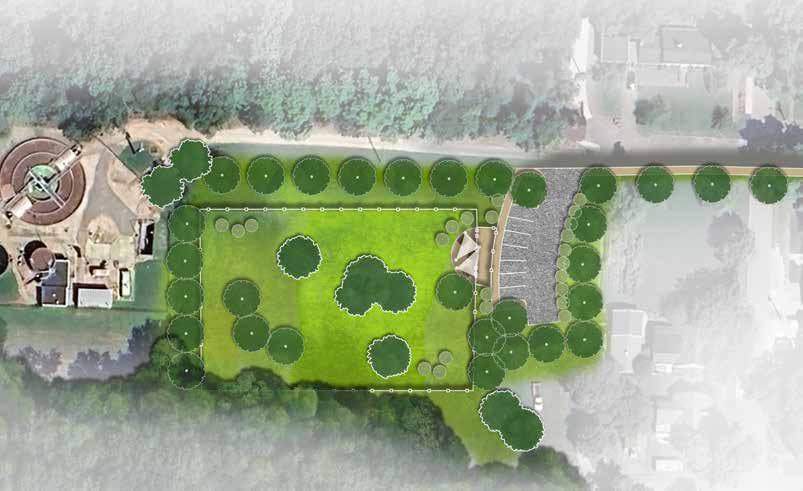
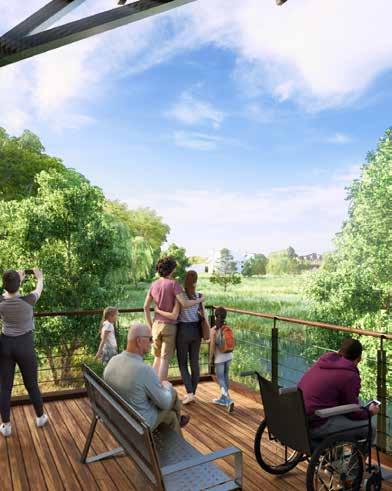
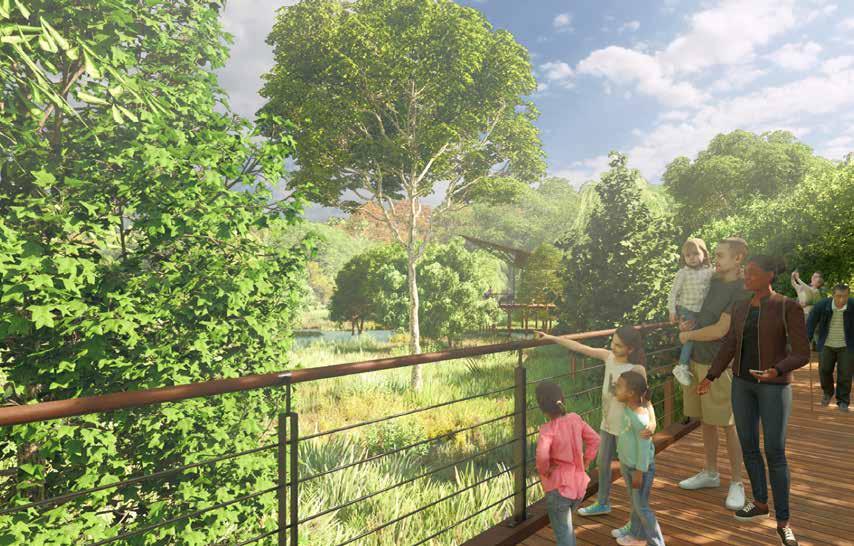
Ensuring dark sky lighting within the parks was well received during Public Meeting #3. This objective would help achieve the goal, “Protect and Enhance Natural Resources.”
The standards adopted in the town parks could also be implemented throughout the town.
Summary of Improvements
A study was performed for Murphy Park to determine the number of fixtures that could be needed on the exterior ring road. The following criteria were used to develop the photometric plan and would be a starting point for future implementation at either Maclure Park or Murphy Park. Lighting of roadways and sidewalks in the town may require a different threshold of lighting.
• 0.5 footcandles average cover for areas that are determined to need lighting. Avoid transitions that result in darkness between light fixtures. It can be difficult for eye adjustments to occur between light and dark changes in spaces.
• 0-1 U value BUG rating, dark sky compliance lighting
• fixture positioned 16 feet above the ground. The threshold allows for vehicles and campers to pass underneath. Height adjustments may be necessary depending upon different use areas. Pedestrian only areas may have short fixture heights.
• LED is recommended to reduce energy usage, but a more natural color of white light, less than, 3000K, could be considered
• Avoid fixtures with glass, or glass-similar lamps. These may break over time due to weather or vandalism. Glassless fixtures have less maintenance concerns.
The fixtures noted in the plan are potential options for use within the town parks,but are also viable for replacement of existing fixtures throughout the town. Conversations with lighting manufactures or their representatives would need to occur in order to confirm the reuse of existing poles.
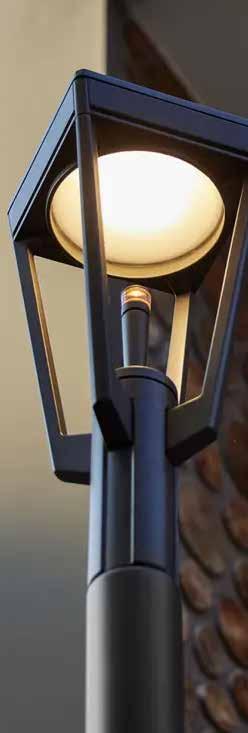
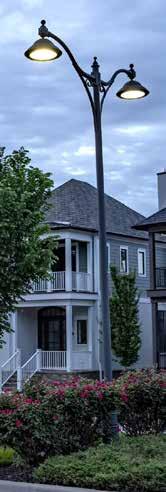
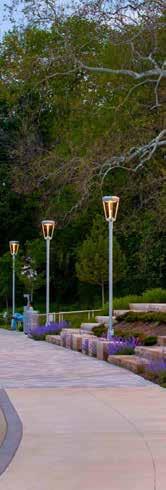
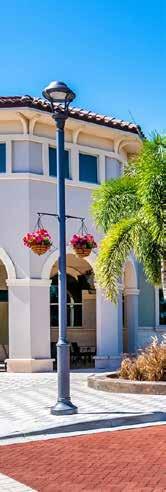
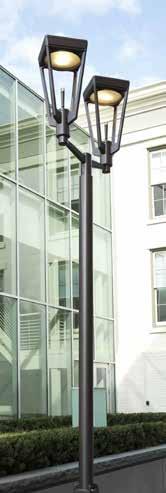
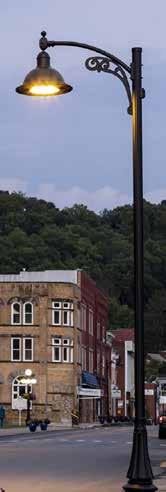
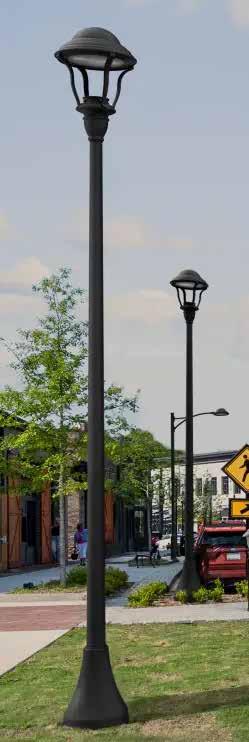
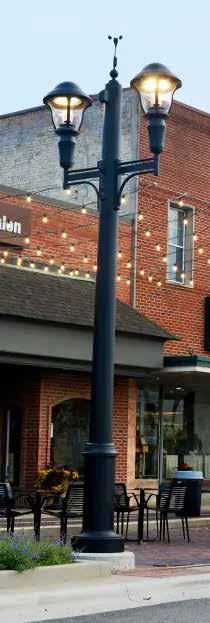
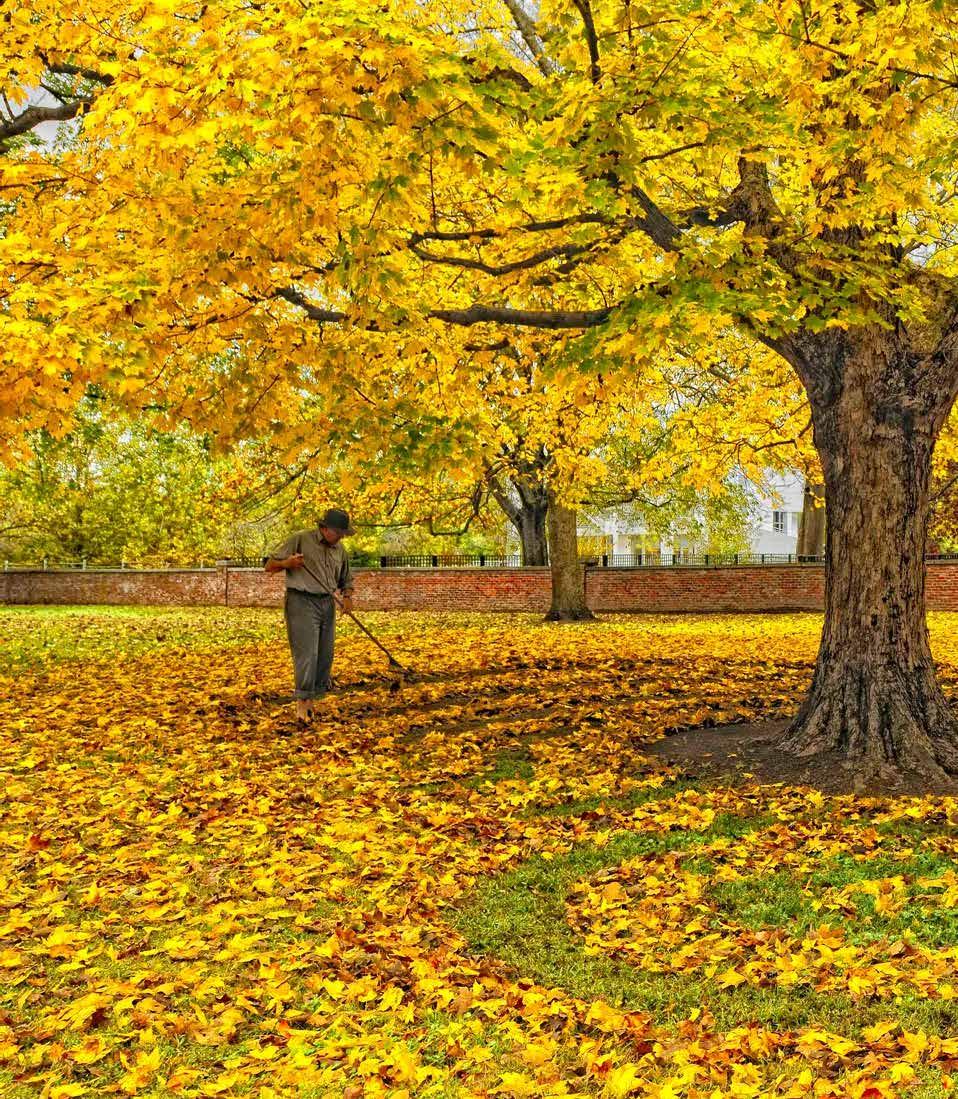

The Action Plan for the New Harmony 5-Year Parks Plan is focused on the goals and objectives defined in the plan. The objectives will help contribute to the accomplishment of each goal. A timeline of when the objectives may be implemented is also noted.
The matrix will help guide Town Council and the Parks Department. This plan will assist the Town on maintenance efforts related to Murphy Park and Maclure Park, as well as proposed amenities. Some objectives in the action recommend work occur in various stages, short term, mid term, and long term. It is typical for some objectives to be addressed in various phases, such as grant applications for park funding. These applications will ideally occur more than once and likely over a period of time.
The action plan should be adapted to meet the changing goals or needs of the community over time. Funding that may become available may also dictate that some improvements become a priority. Additionally, the availability of Town Council and the Parks Department to take on one or more of these projects over time should be considered, especially for a community with the population the size of New Harmony.
Apply for grants and identify sources of matching funds to use toward grant opportunities.
Partner with an existing non-profit group, or consider developing an existing “Parks Foundation” to assist with fundraising efforts for parks maintenance and future improvements
Encourage allocation of more money toward the park’s budget.
Continue conversations with local and state philanthropic, non-profit, and educational organizations regarding proposed improvements identified in Park Master Plan
Ensure awareness of Parks and Recreation activities, facilities, programs, and projects
maintenance needs of each park and facility and create an
regular inspection and maintenance of park amenities and equipment and document all activities.
Maintain current playground amenities and improve accessibility to existing equipment
Further develop park master plan to determine future amenities, including phasing plan
Construction Documents and Construction of Proposed Park Amenities (playground or spray plaza, etc.)
Allocate yearly funds for Playtopia maintenance
Improve park lighting, see goal #1
Maintenance/improvements on existing basketball court
Maintain campsite and camping options (grills and firepits)
improvements to restroom building
Improve accessibility
Construction Documents and Construction of Proposed Park Amenities (spray plaza, etc.)
Further develop Dog Park master plan to refine amenities and design. Determine operational procedures.
Construction Documents and Construction
Coordinate with IDNR and local landowner(s) on possibility of a trail connection between Harmonie State Park and the Town of New Harmony
Issue RFP (Request for Proposals) feasibility study for a consultant to determine the routing and technical requirements of the proposed trail
Construction Documents and Construction
Coordinate with local landowner(s) on possibility of a canopy walk north of the town, utilizing the existing bottomland forests adjacent to the Wabash River
Issue RFP (Request for Proposals) feasibility study for a consultant to determine the routing and technical requirements of the proposed trail
Construction Documents and Construction
and Town Funds, LWCF, Next Level Trails
LWCF, Next Level Trails
and Town Funds, Next Level Trails
Philanthropic and Town Funds, LWCF
LWCF, Next Level Trails
Signage Improvements
Apply for grants and identify sources of matching funds to use toward grant opportunities. • • • See Below for Specific Suggestions
Work with the Town Council to evaluate feasibility of using Park Board bond issue to fund improvements
Encourage allocation of more money toward the park’s budget.
$0 N/A
• • $0 General Fund
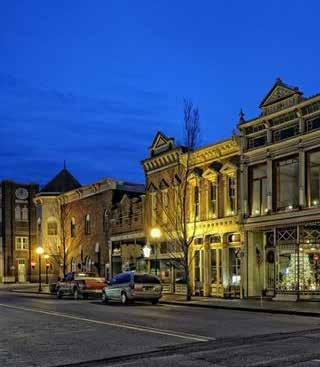
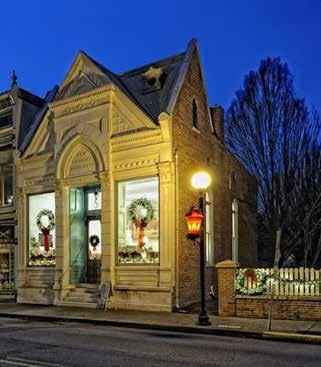
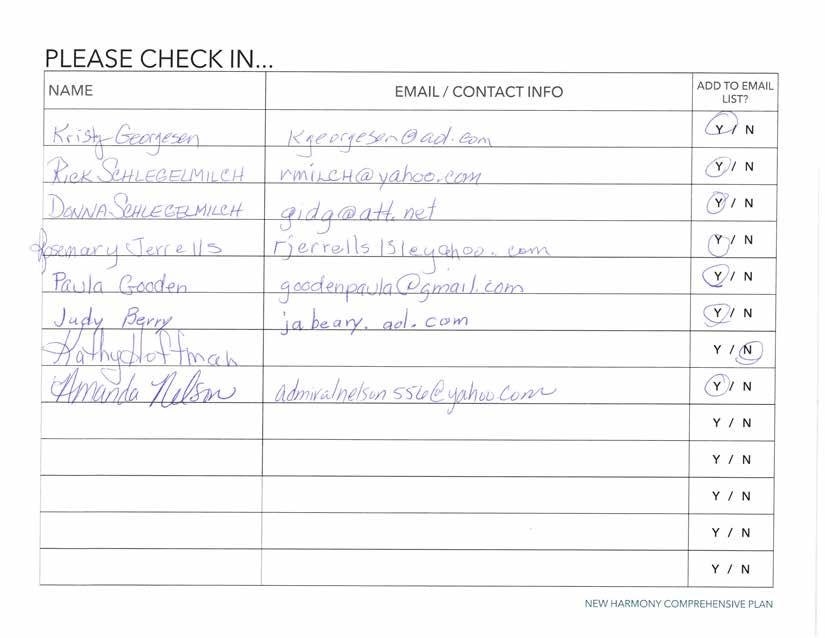
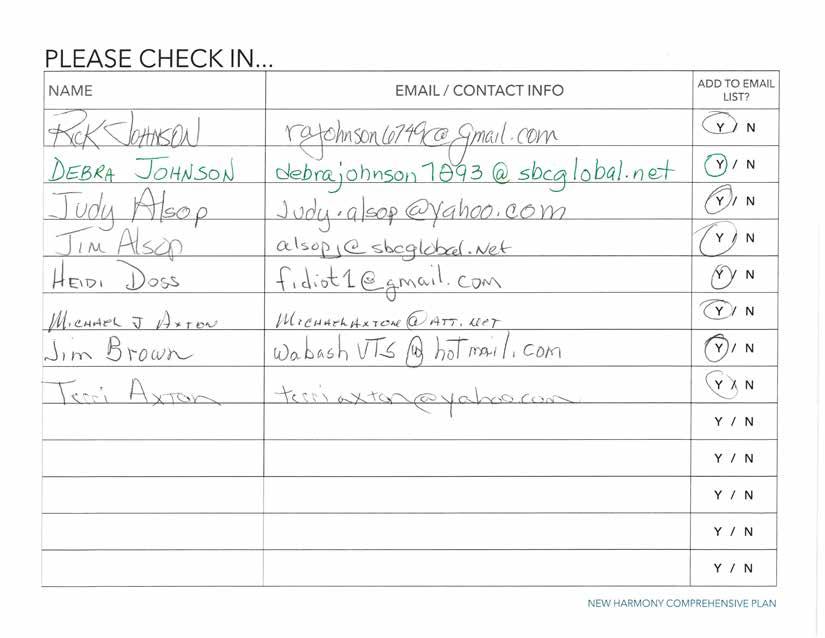

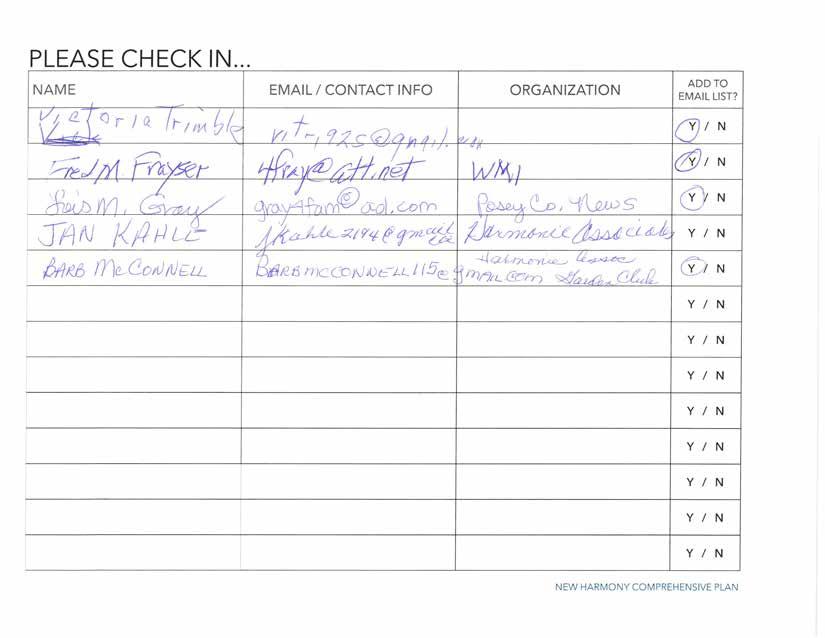



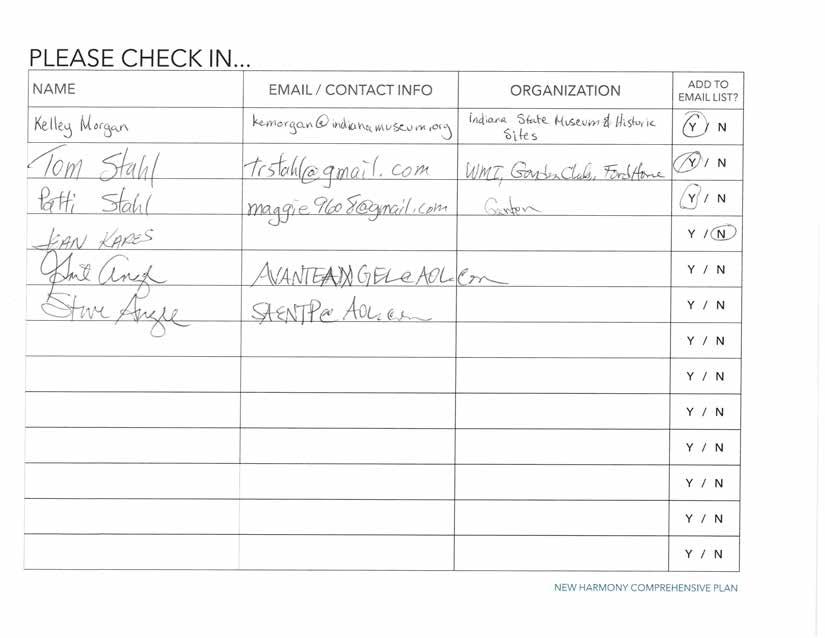
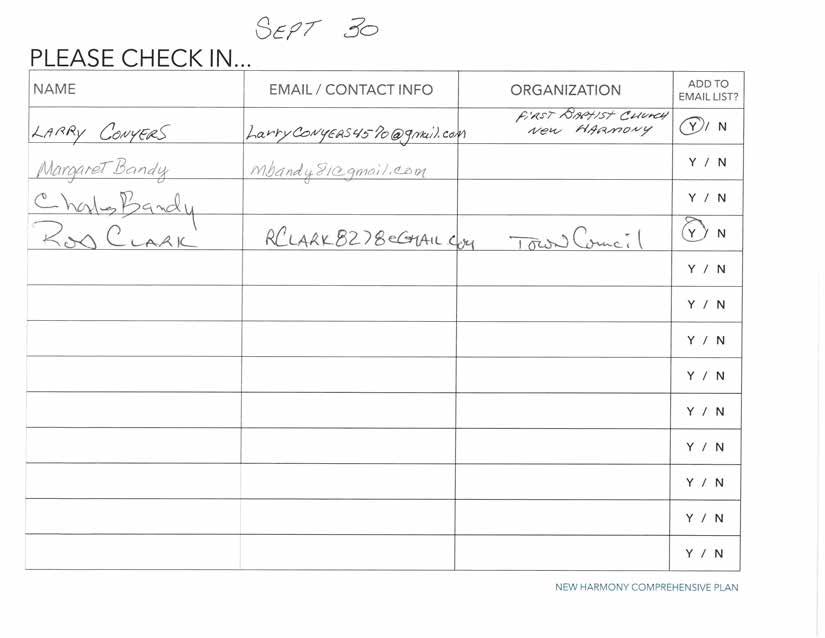
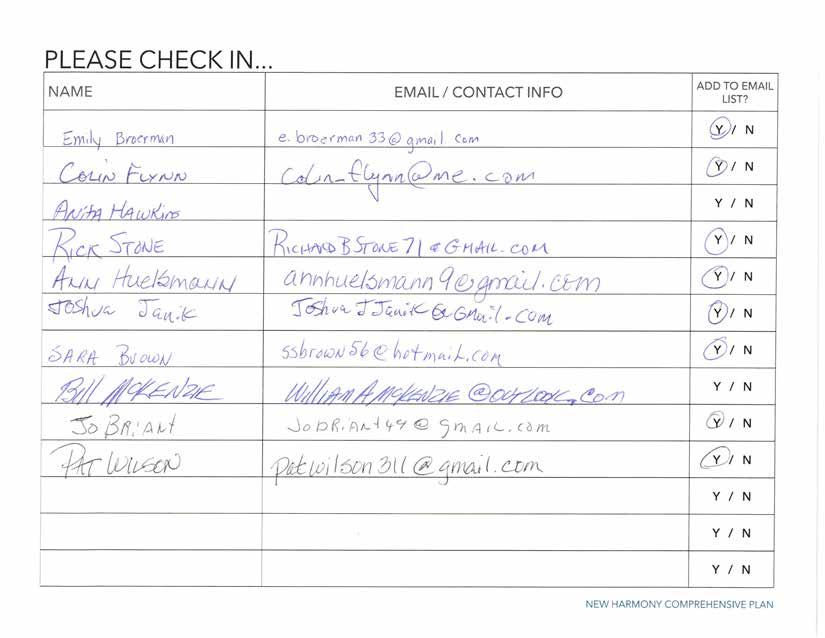

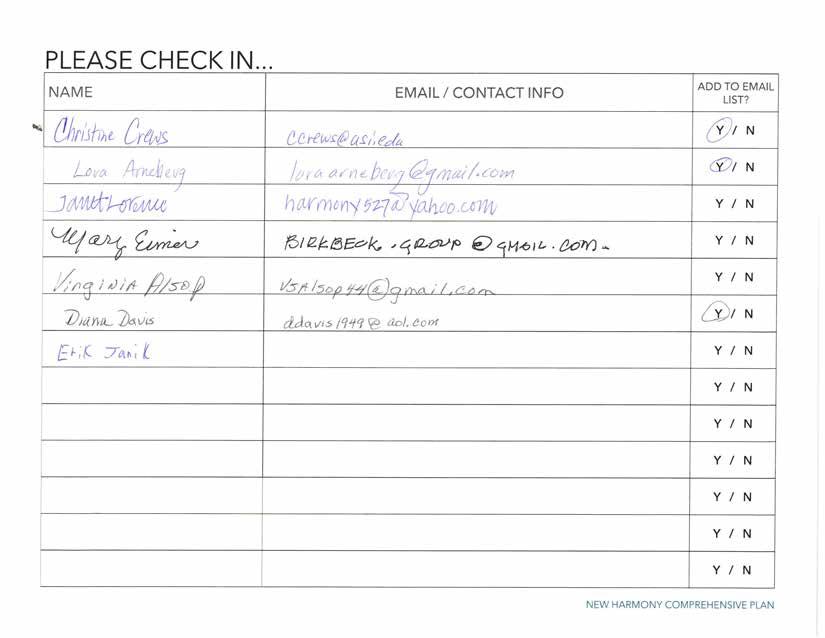
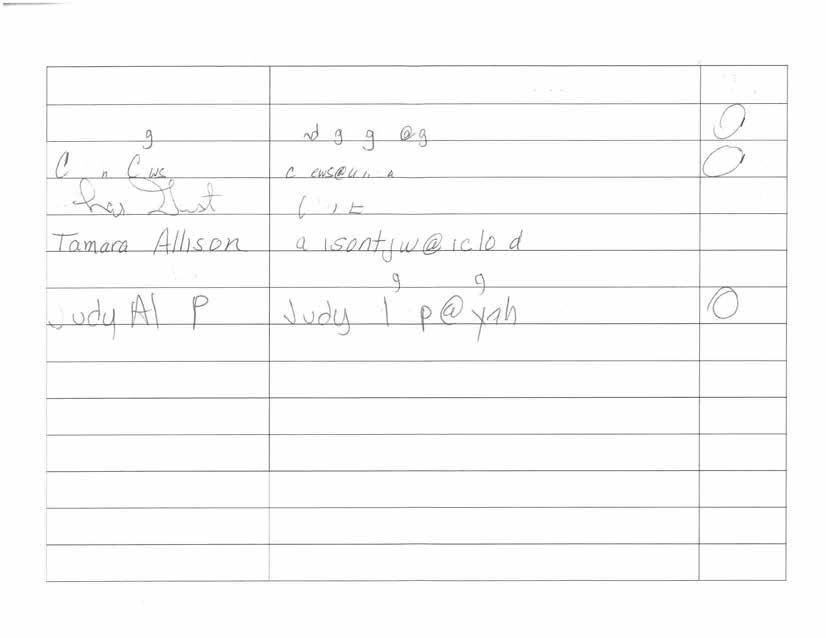
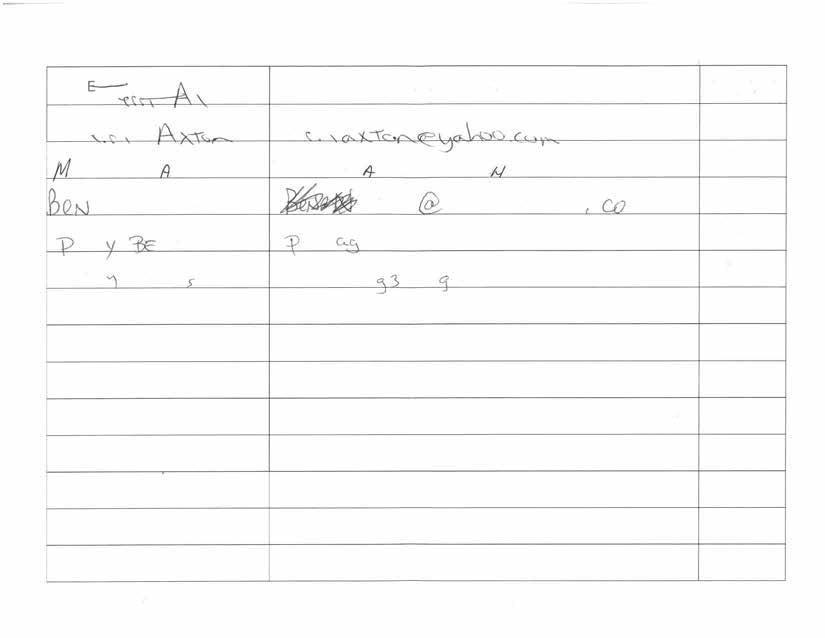

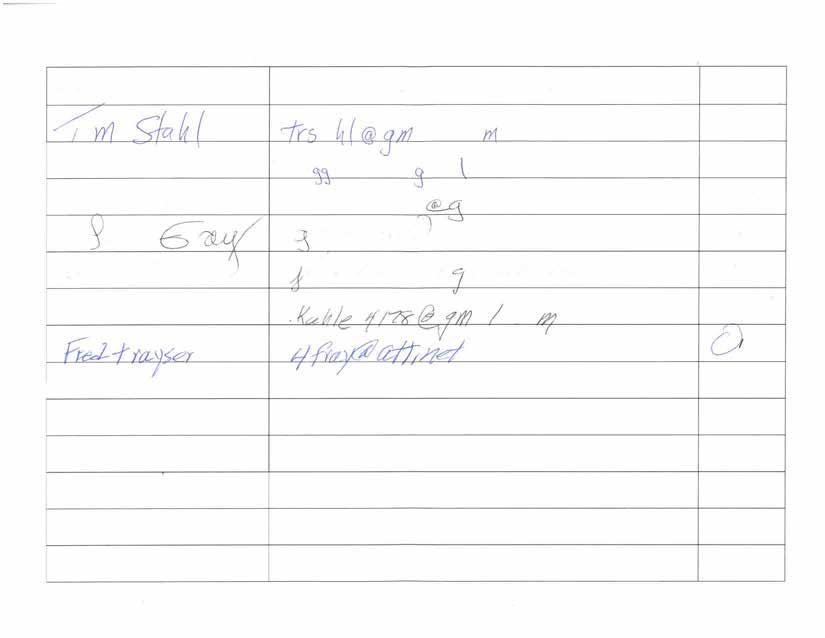
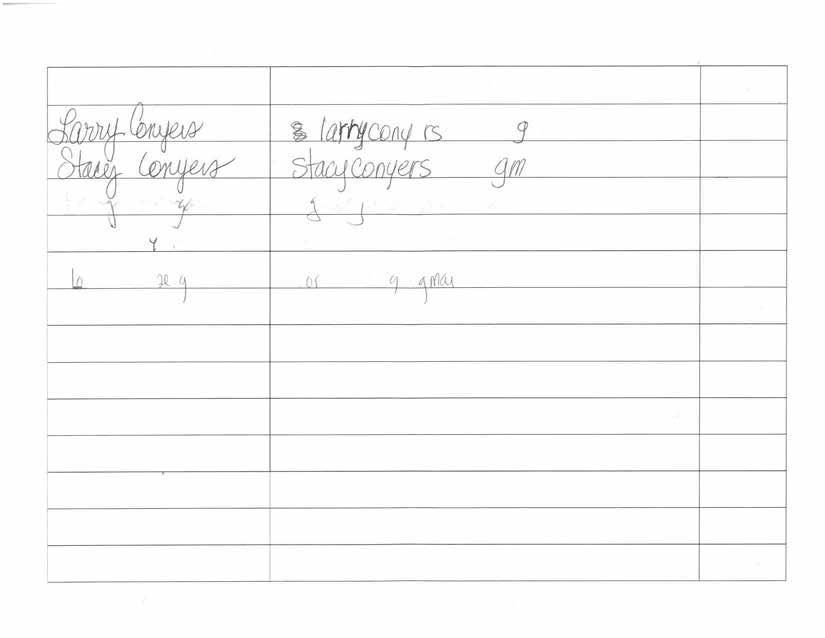
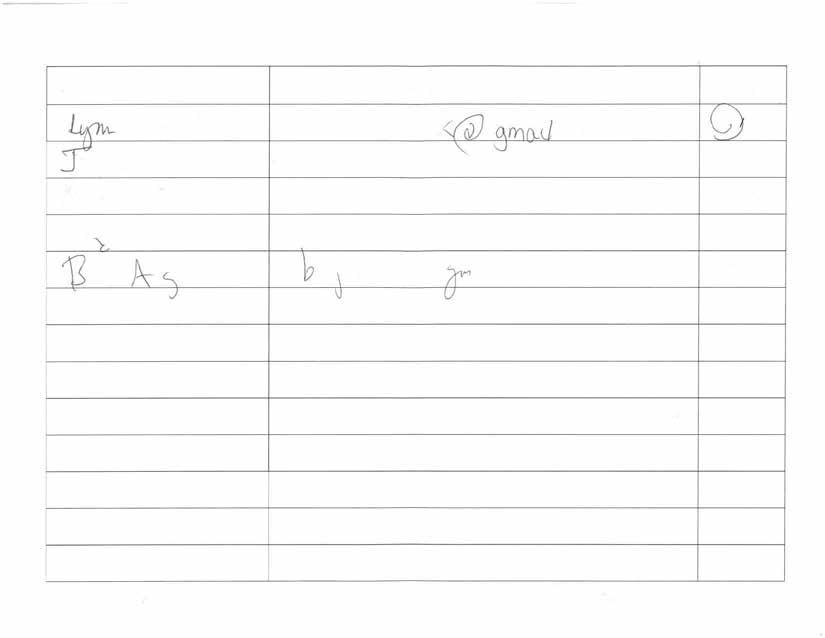


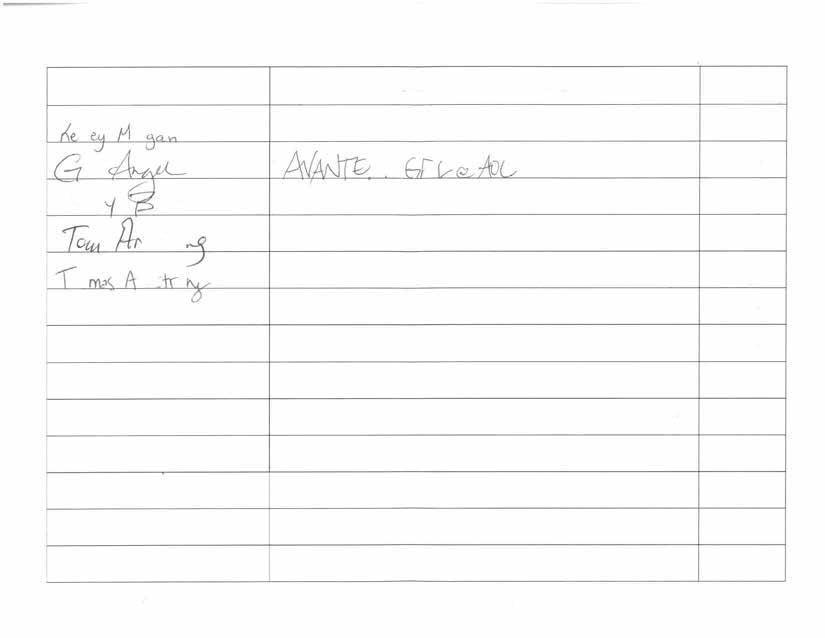
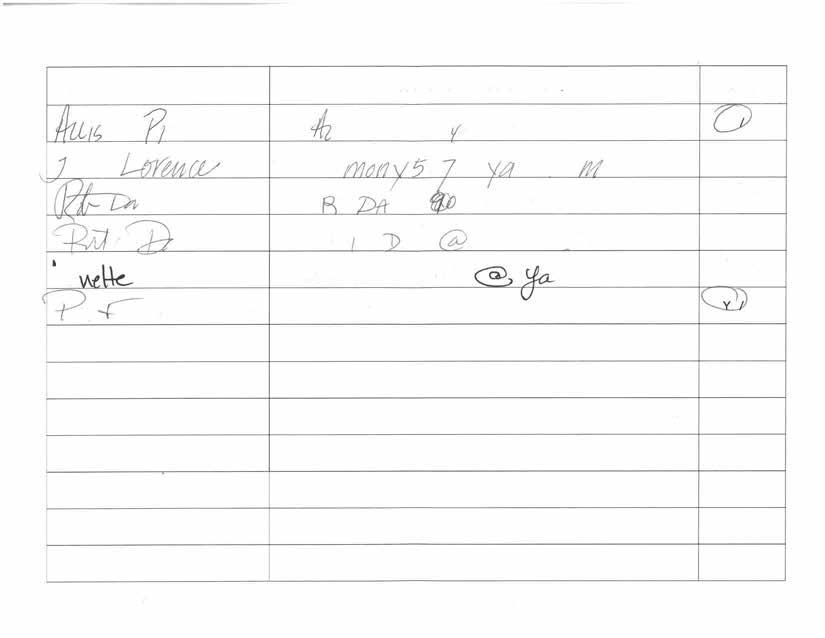

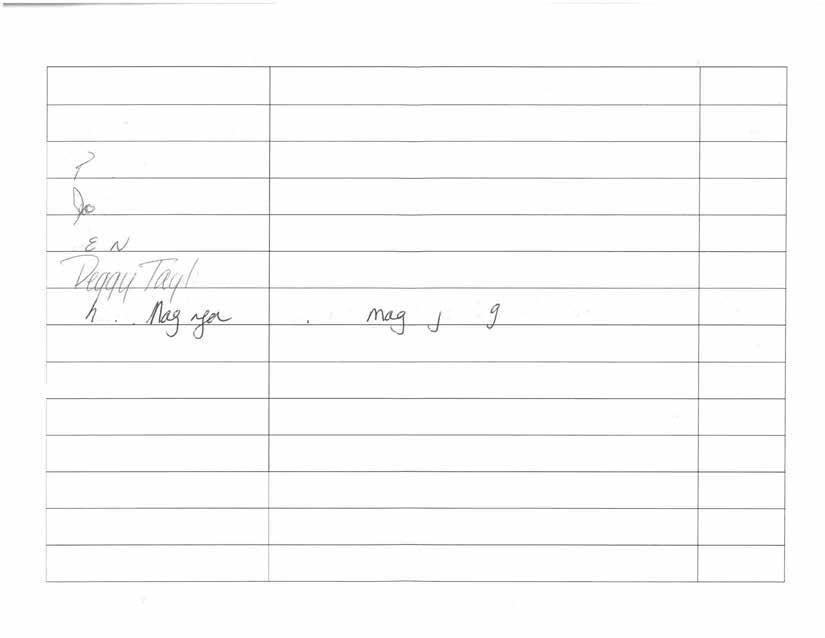

PLEASE CHECK IN ...
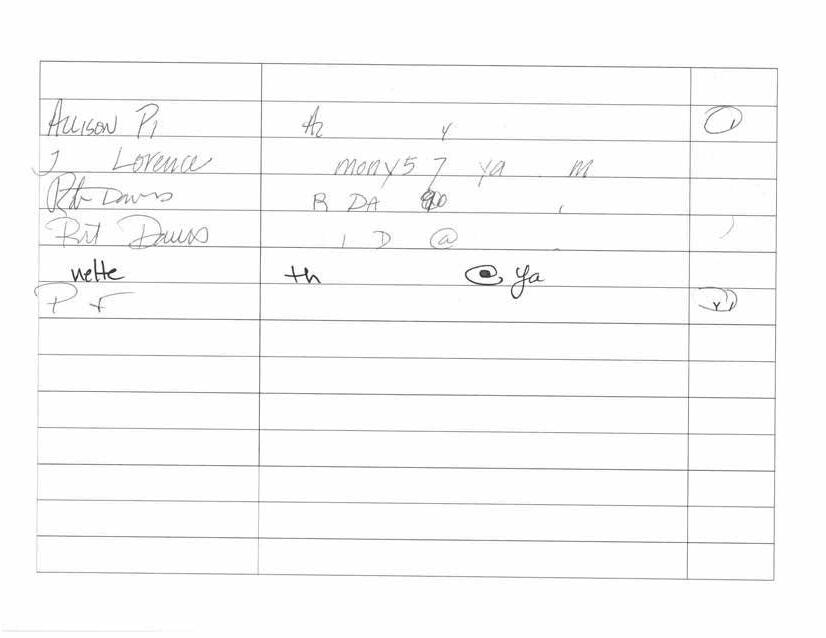
PLEASE CHECK IN ... NAME EMAIL/ CONTACT INFO








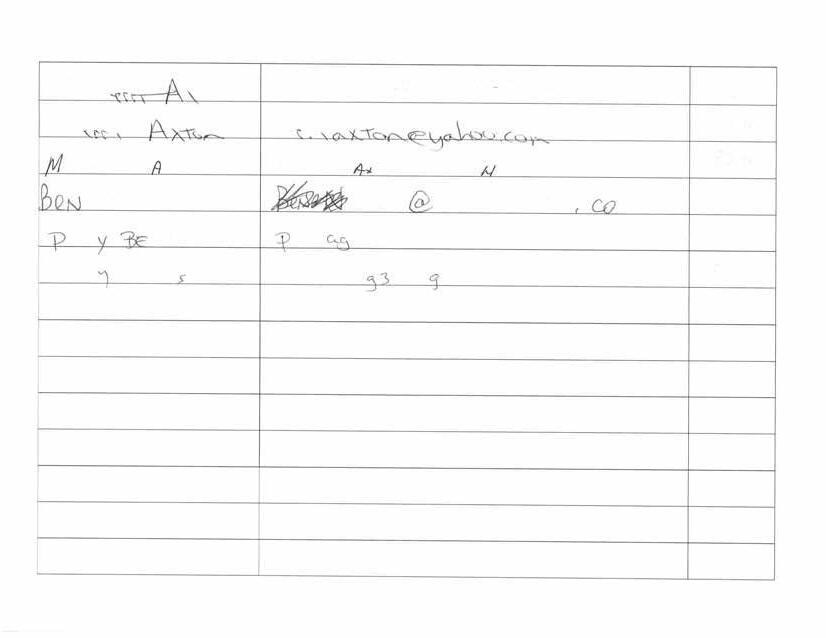



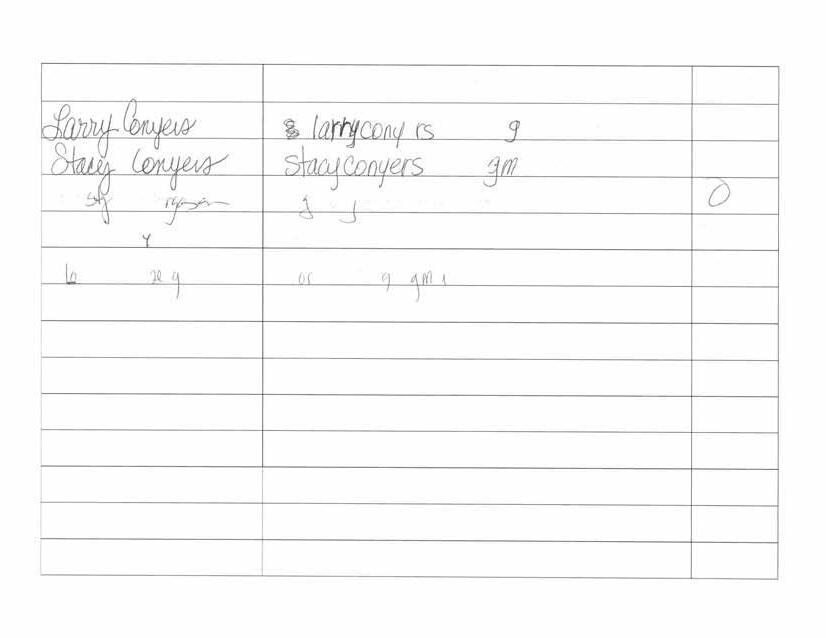

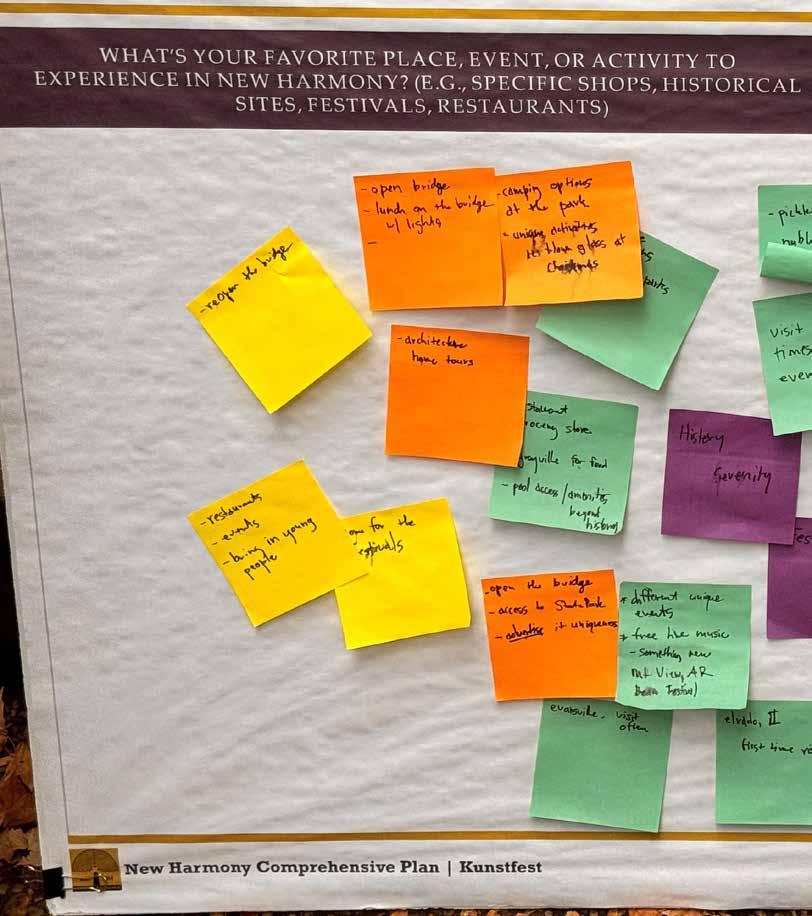


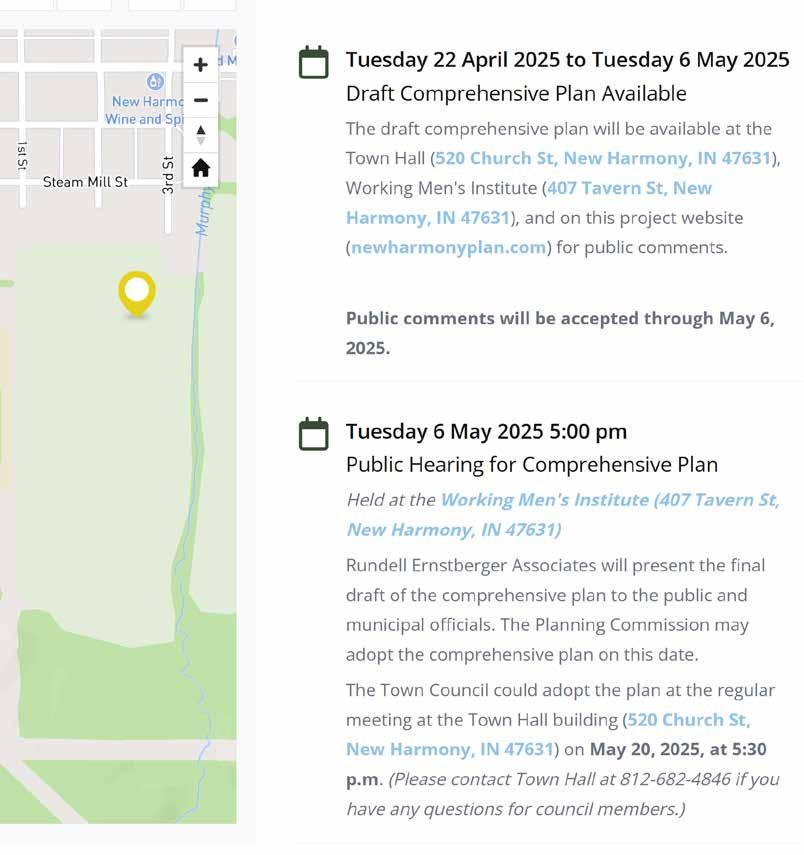
5 Year Parks Plan